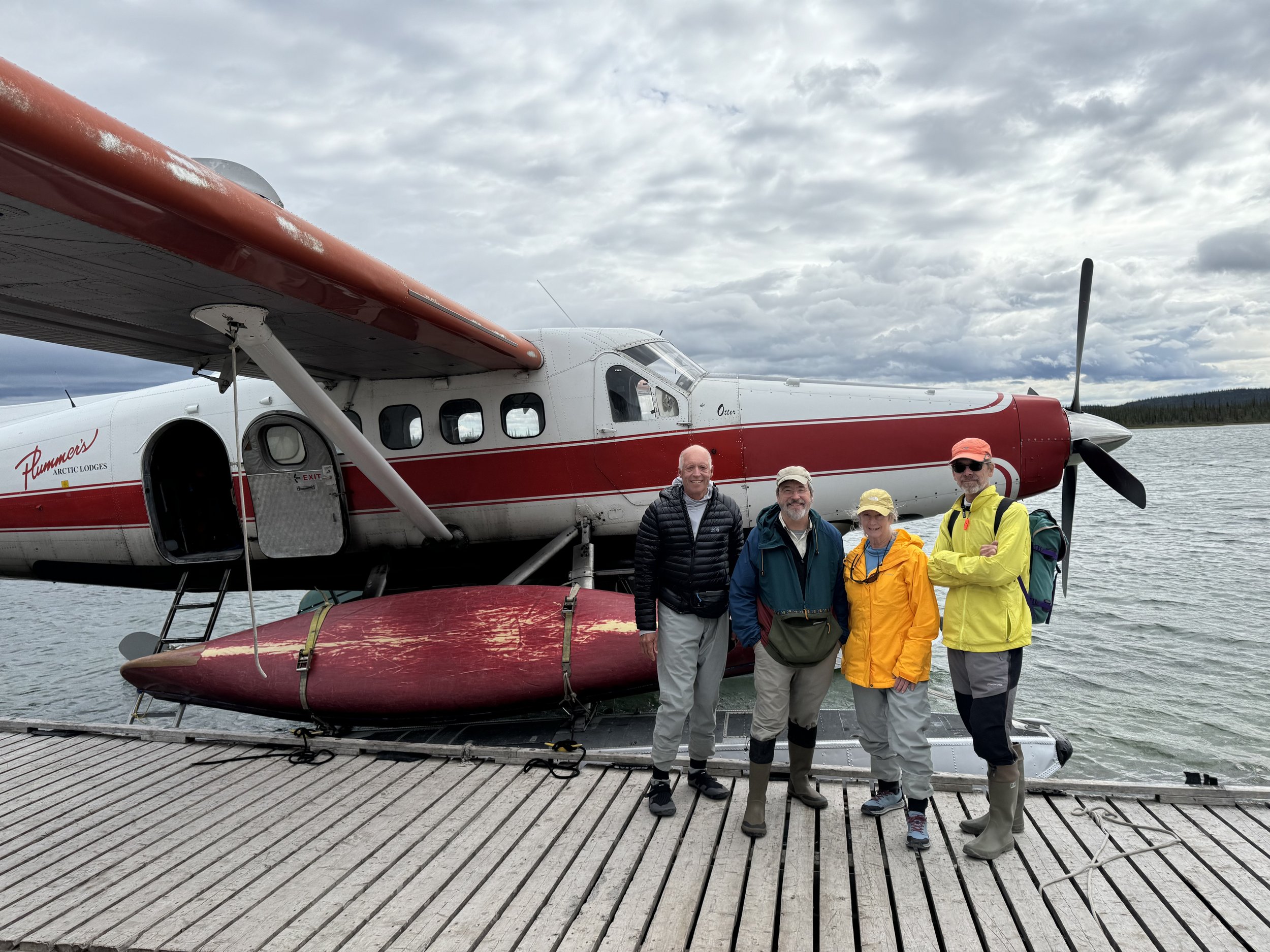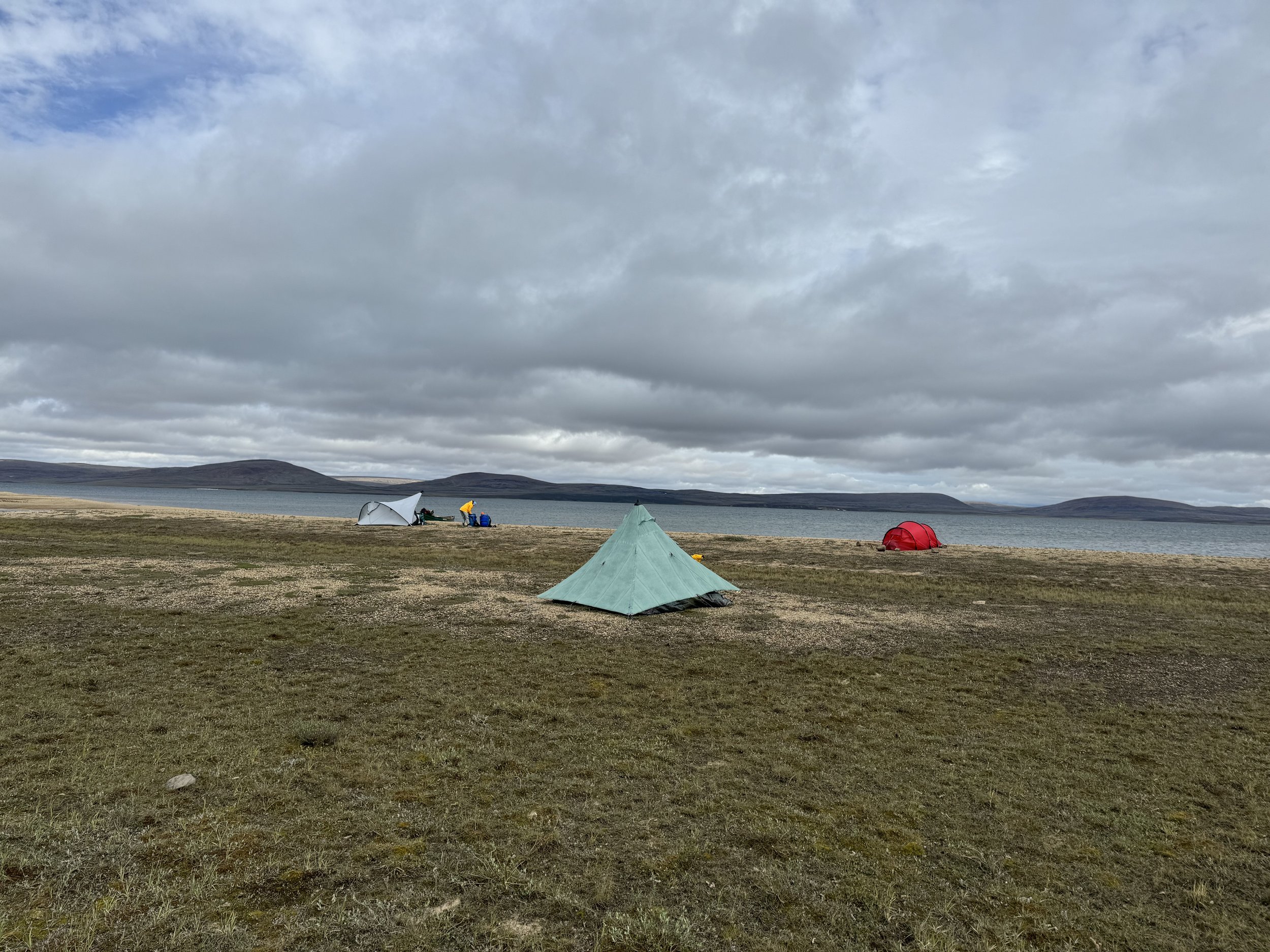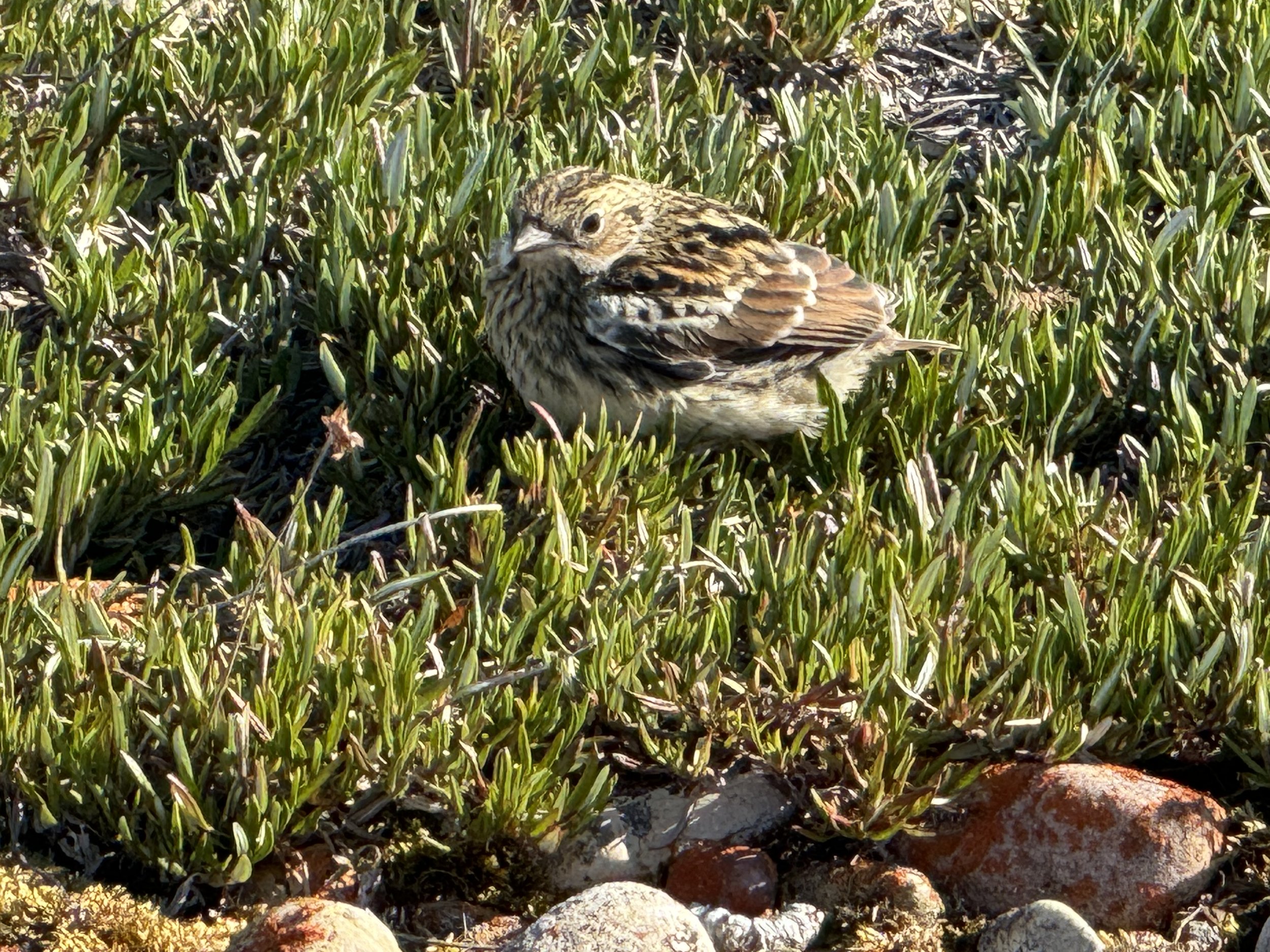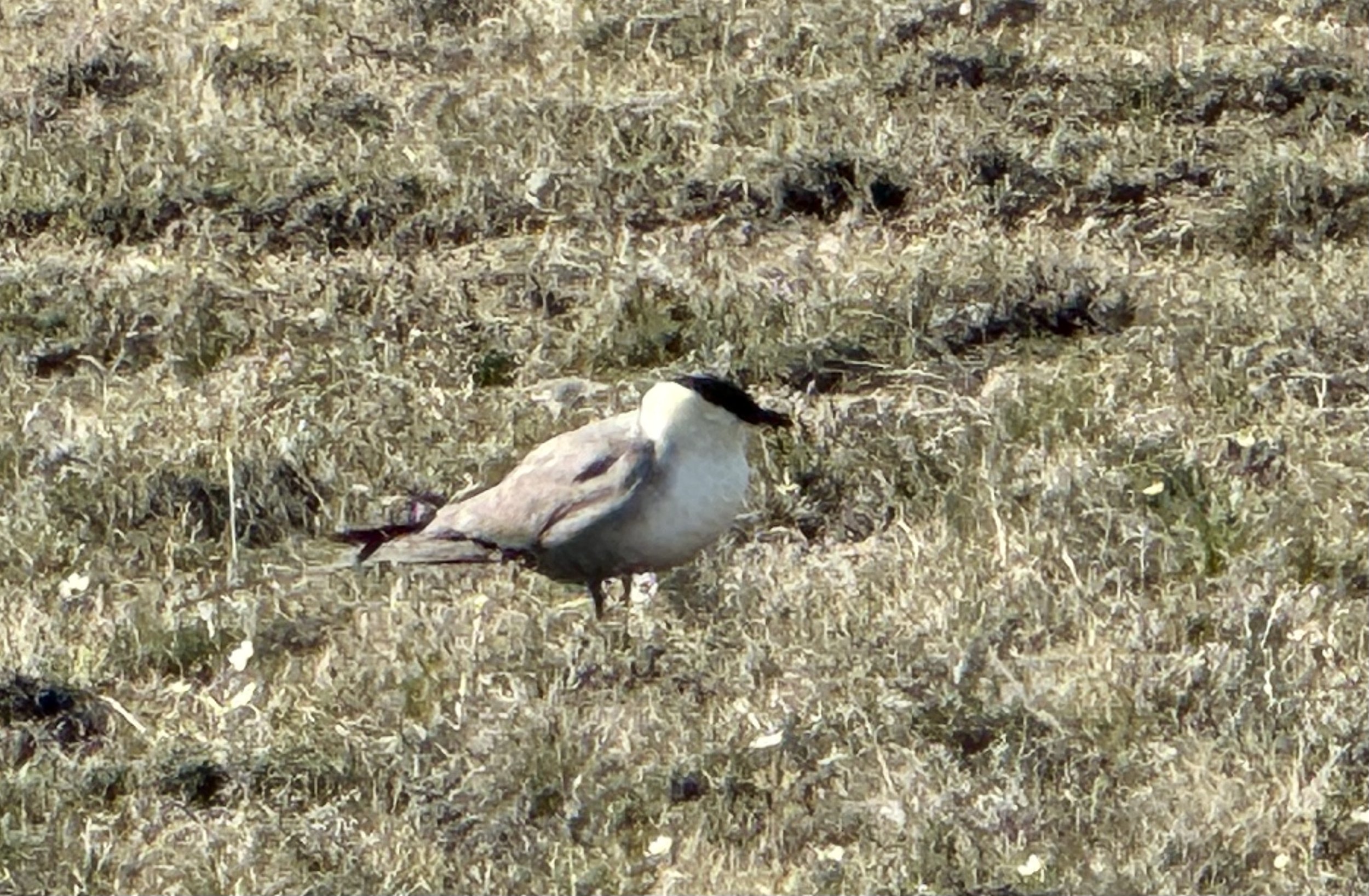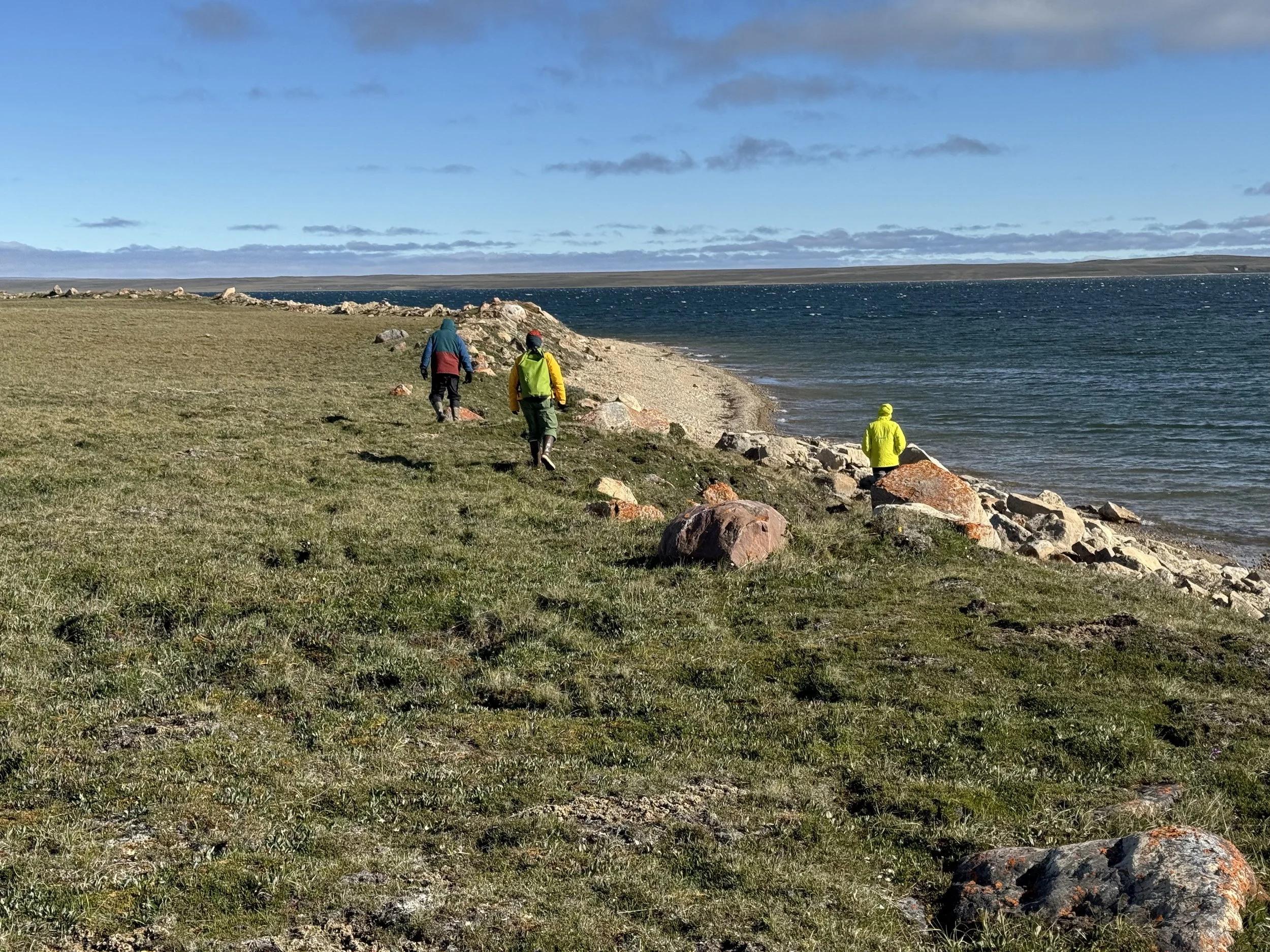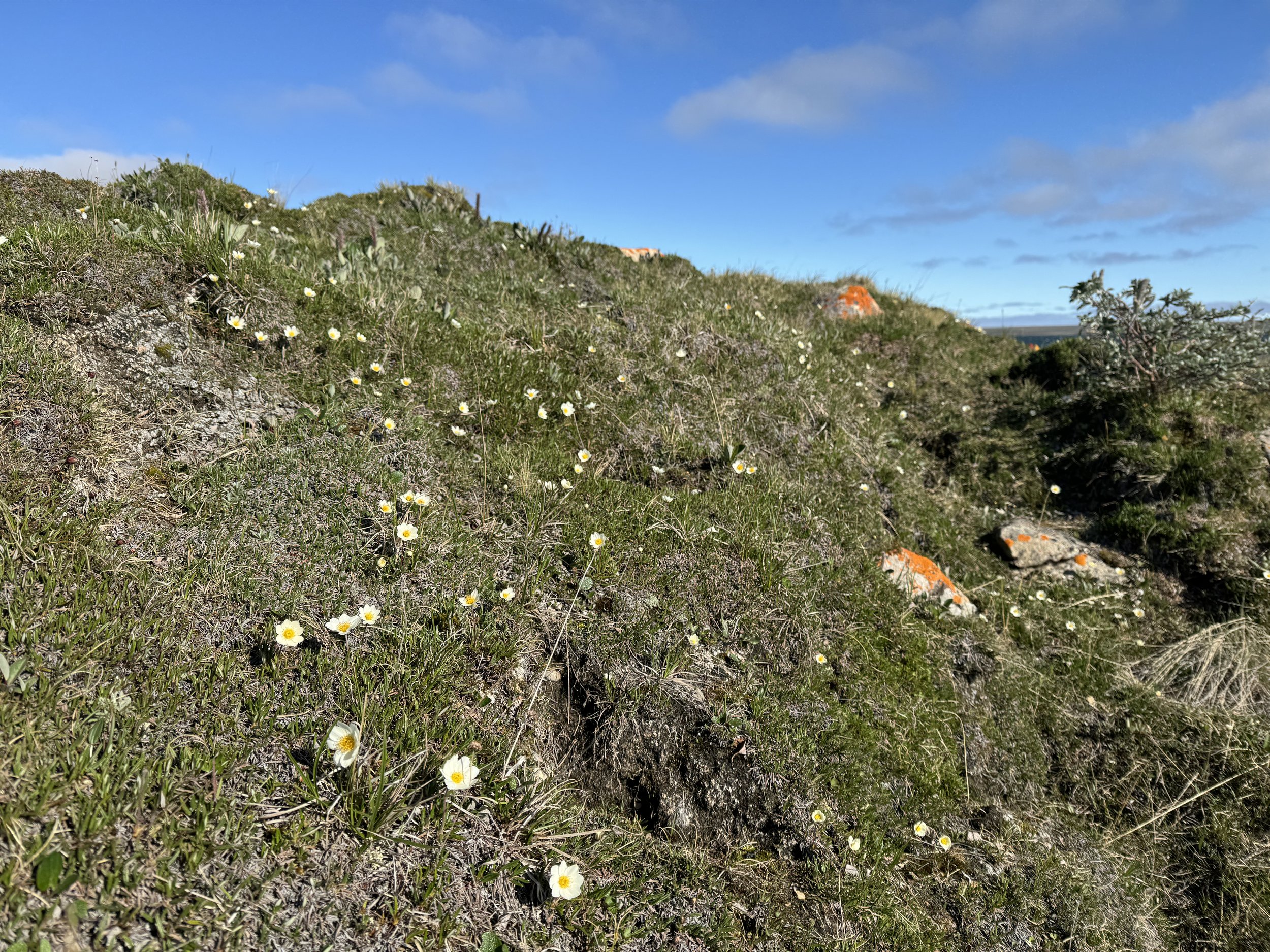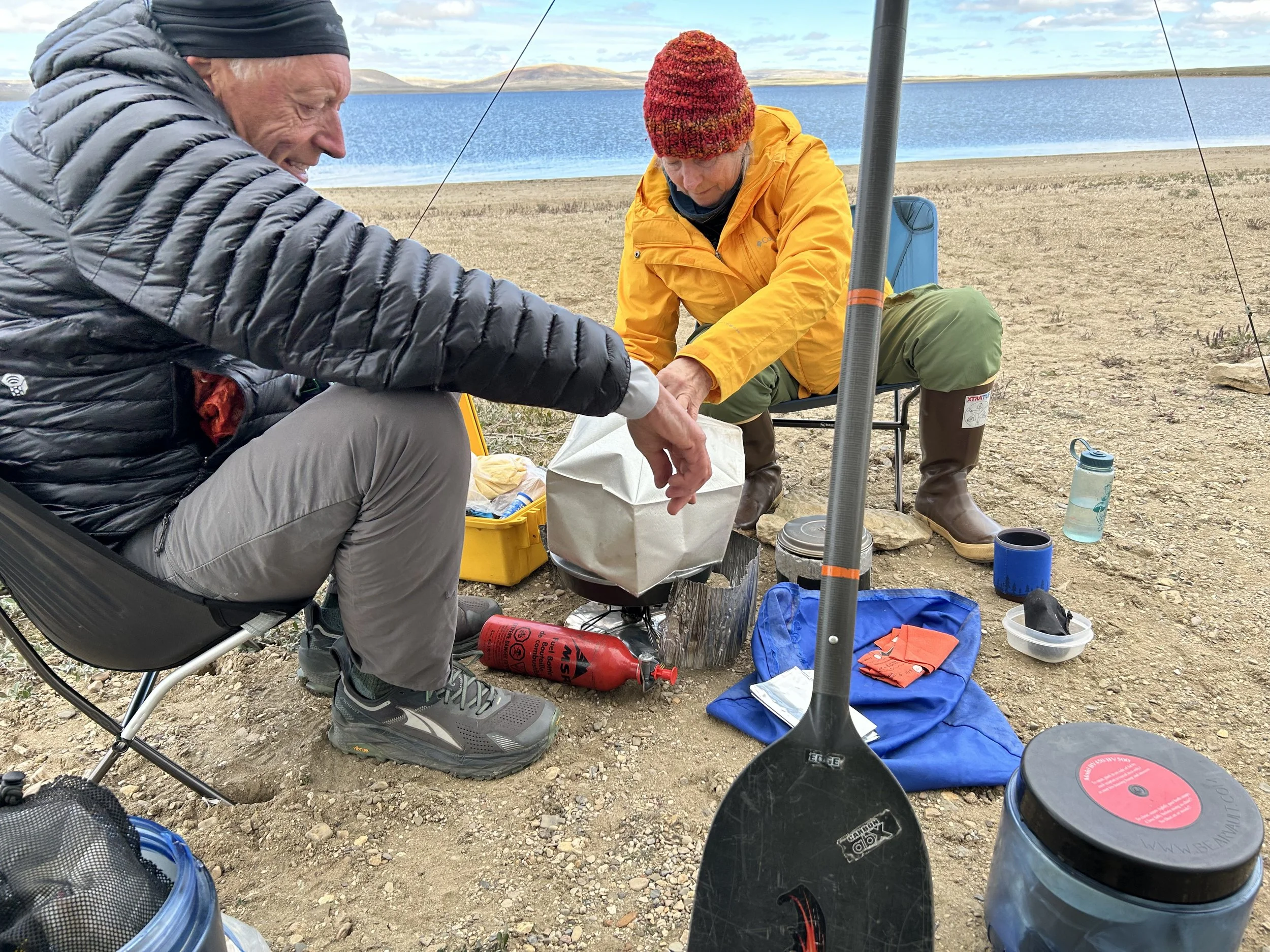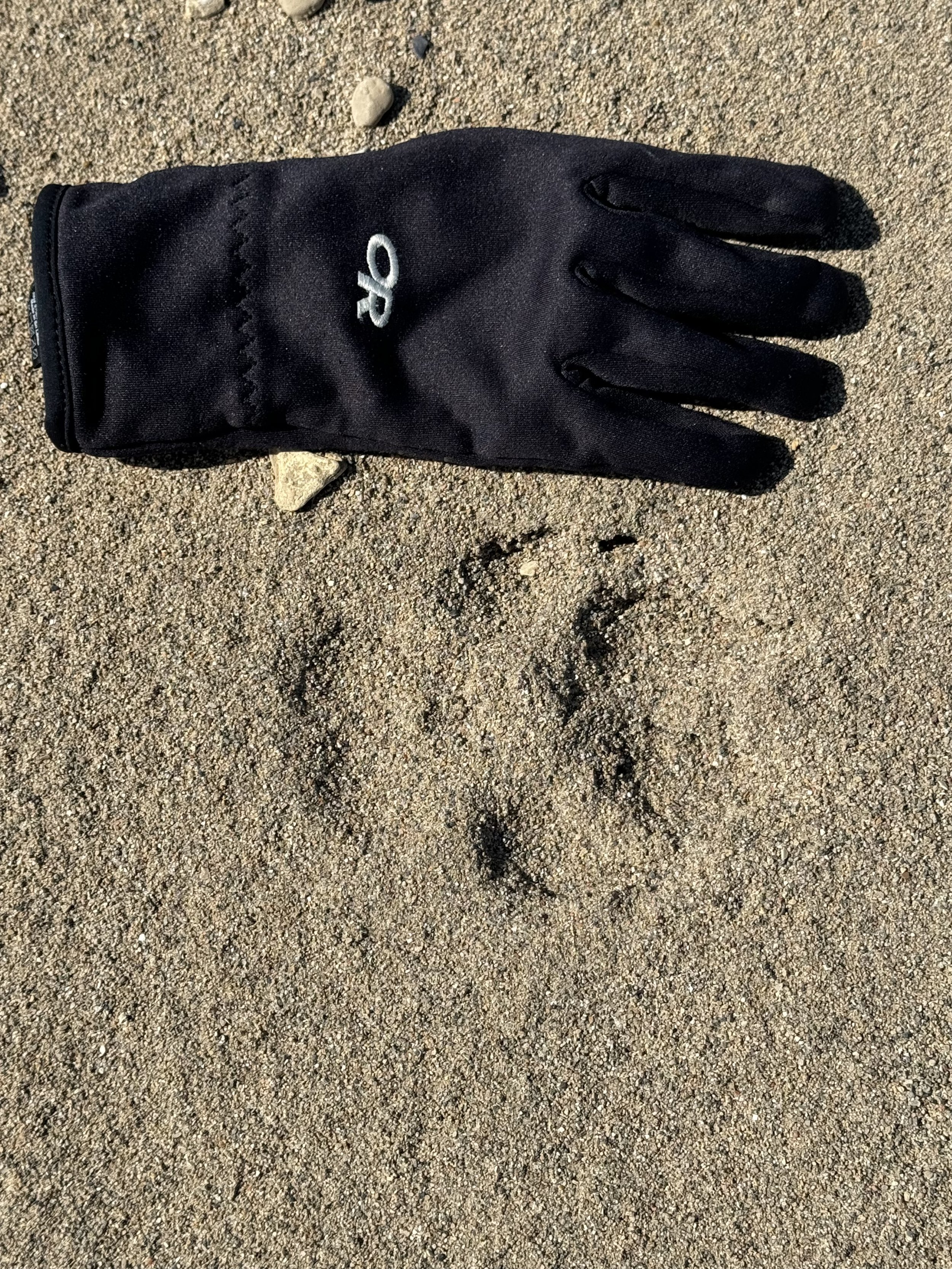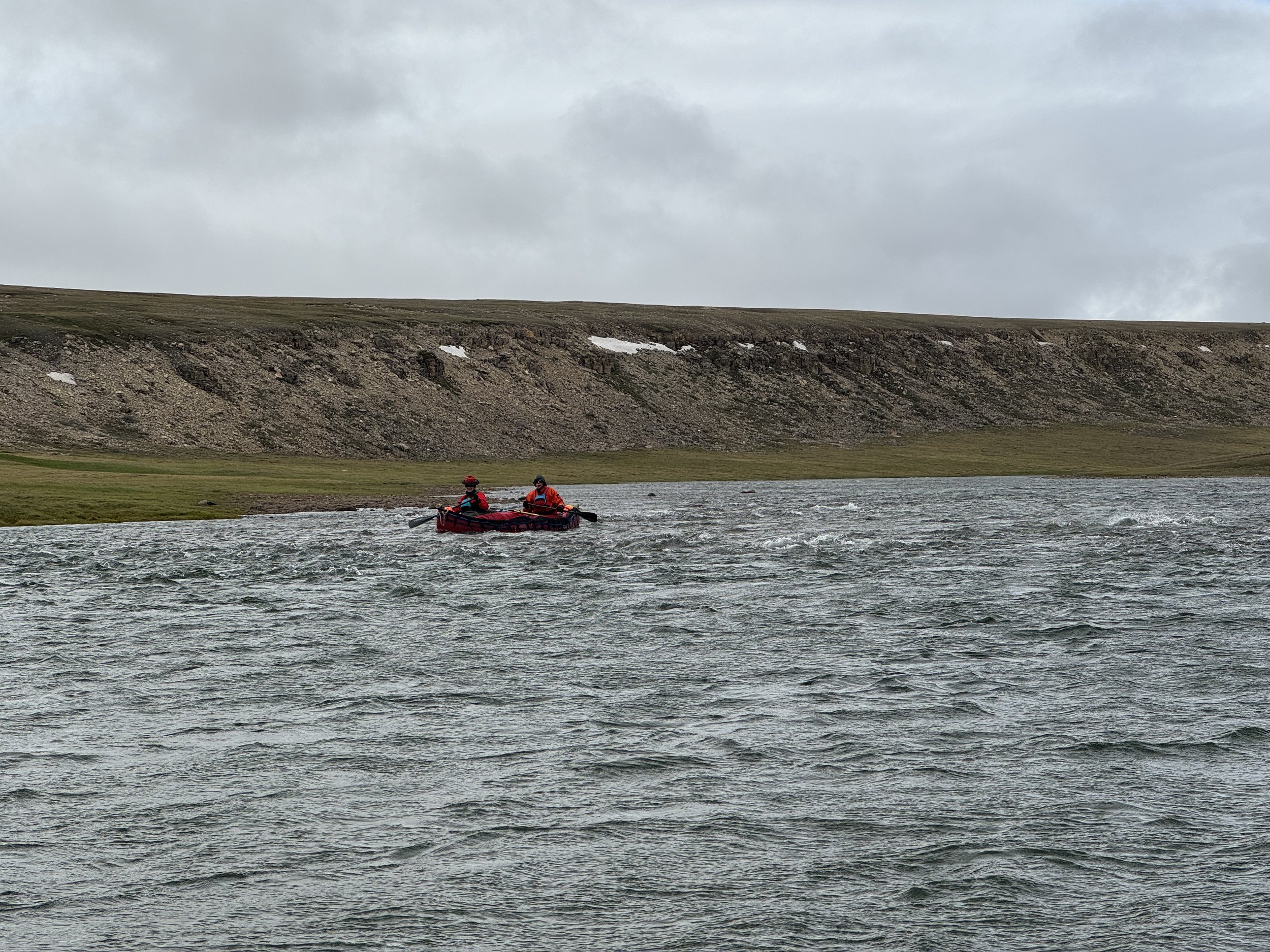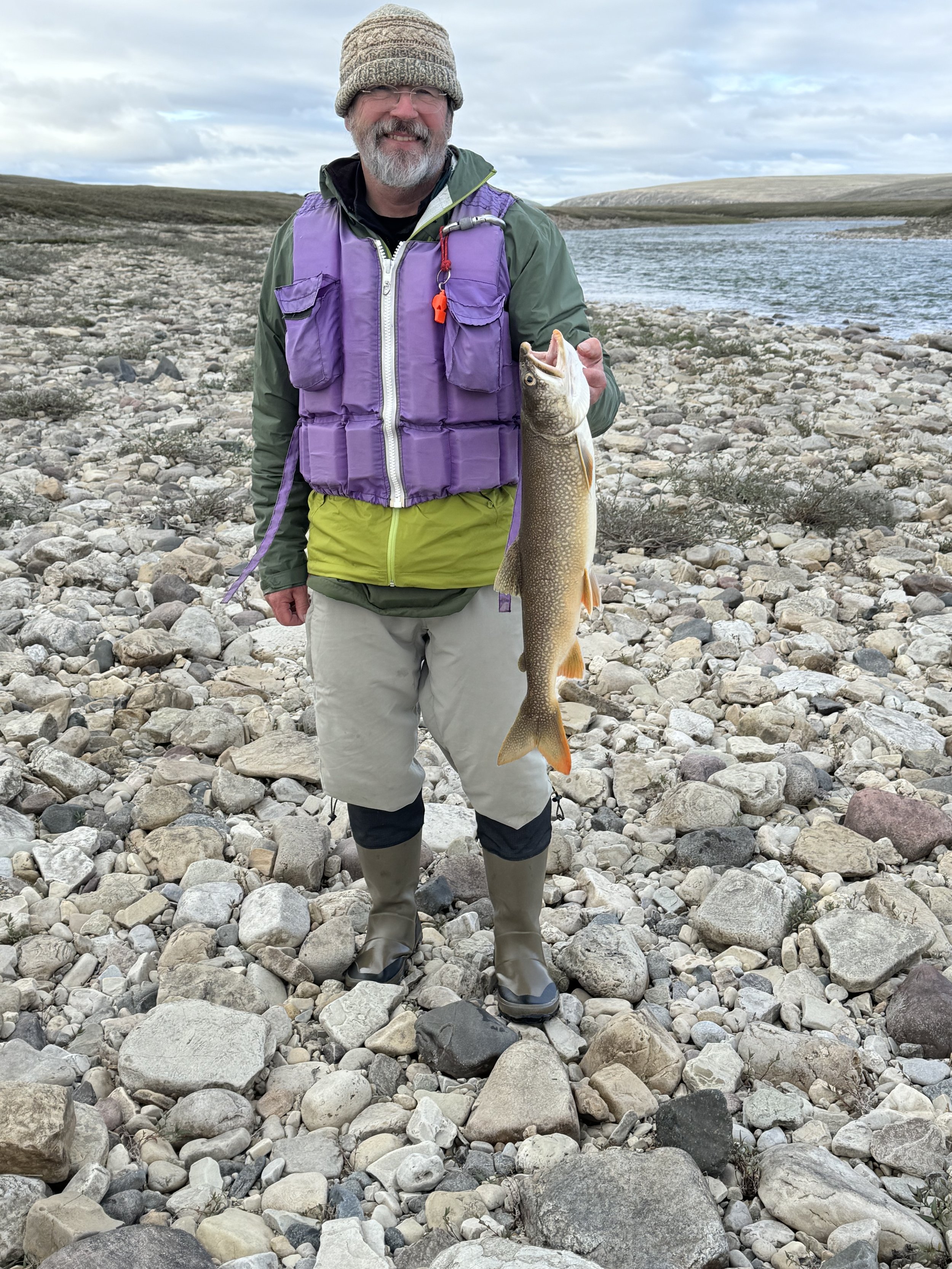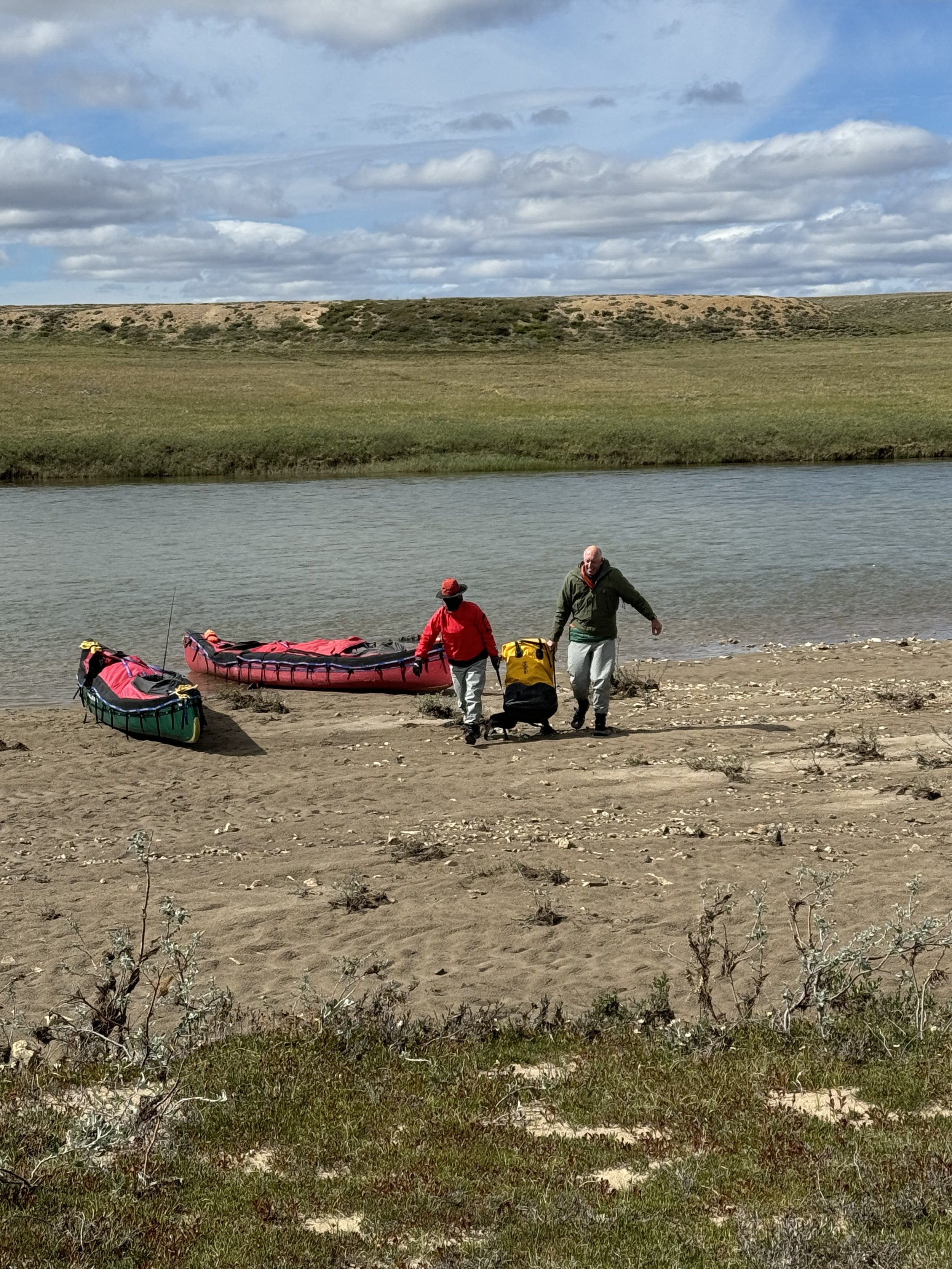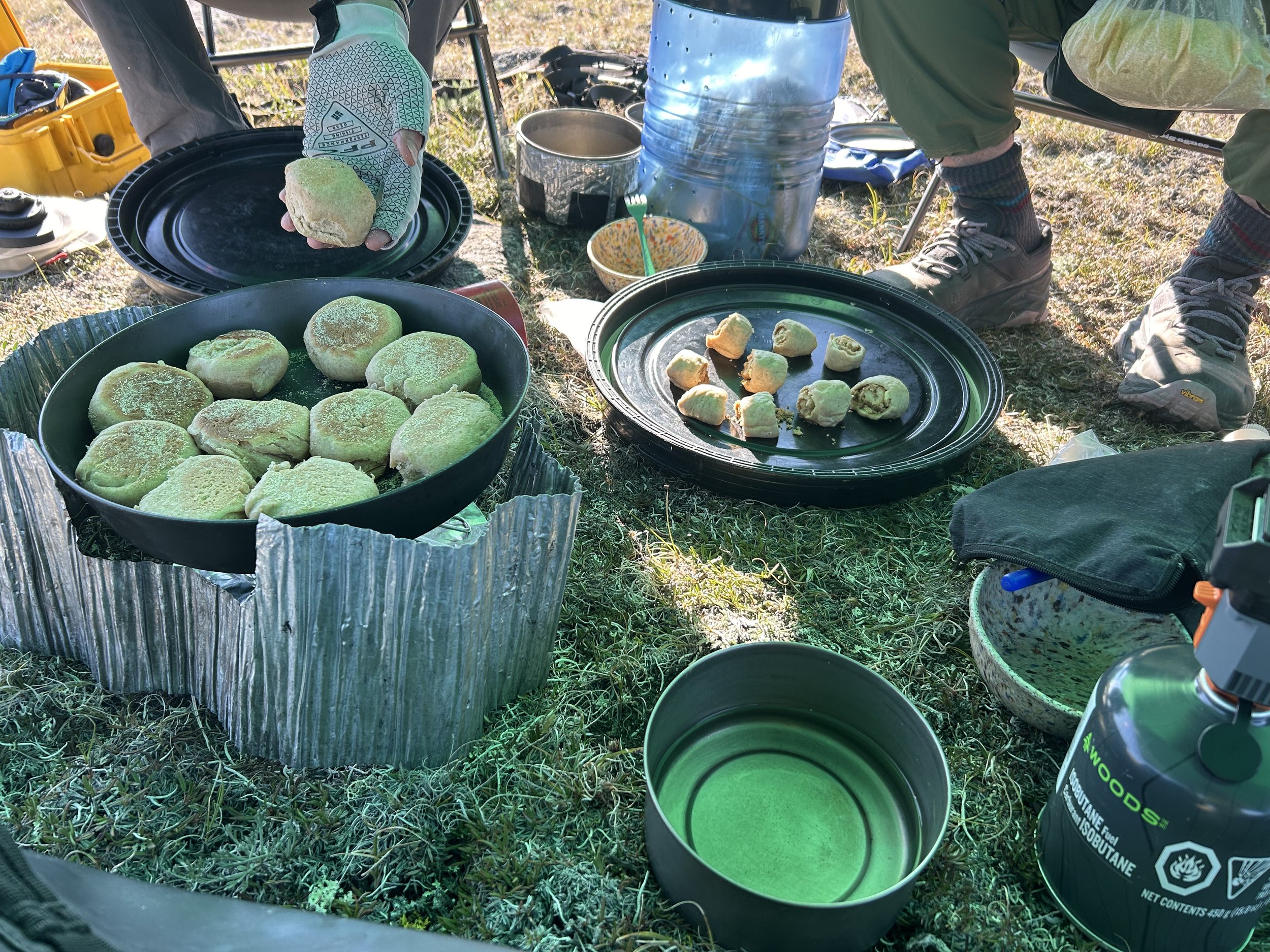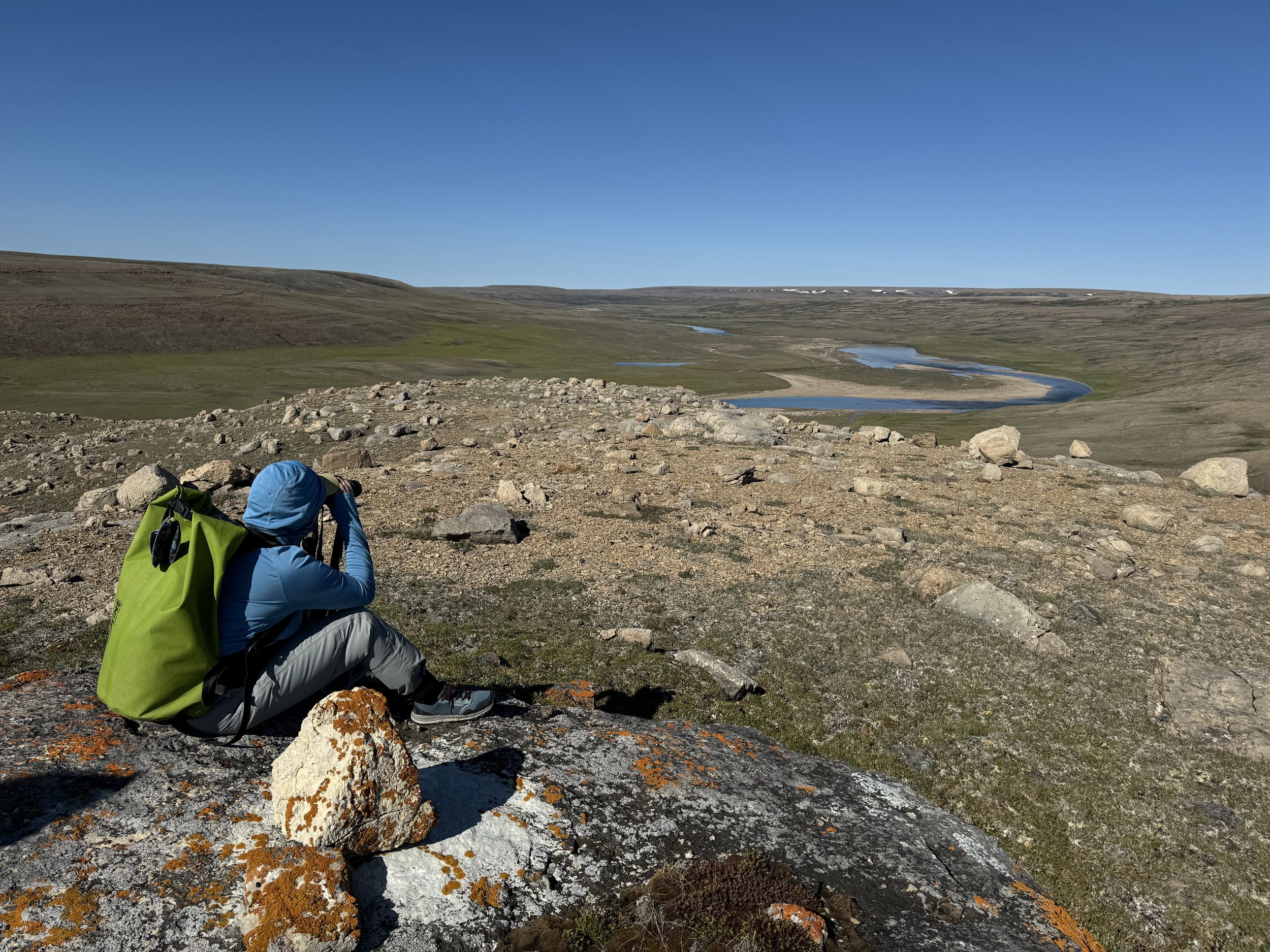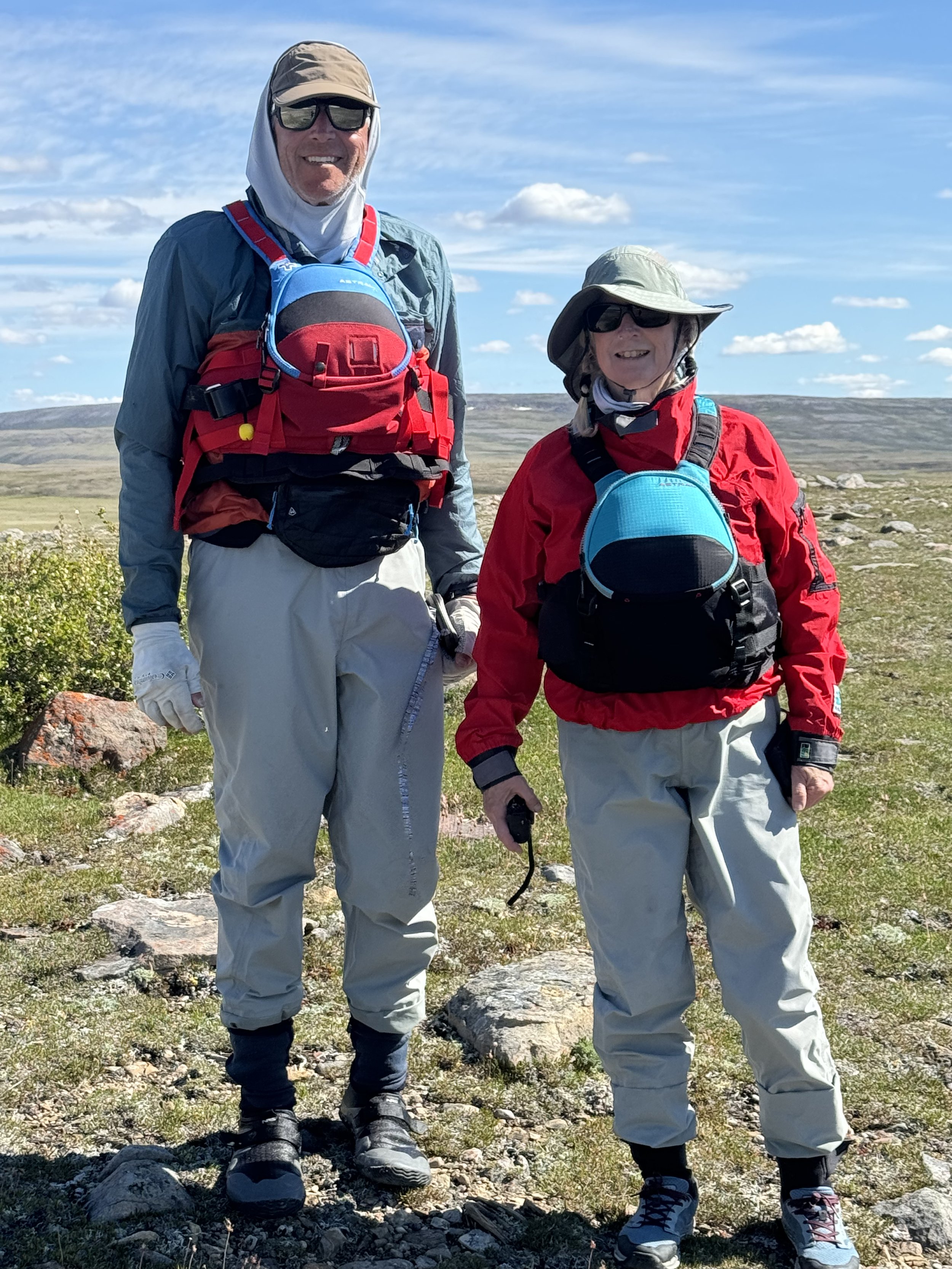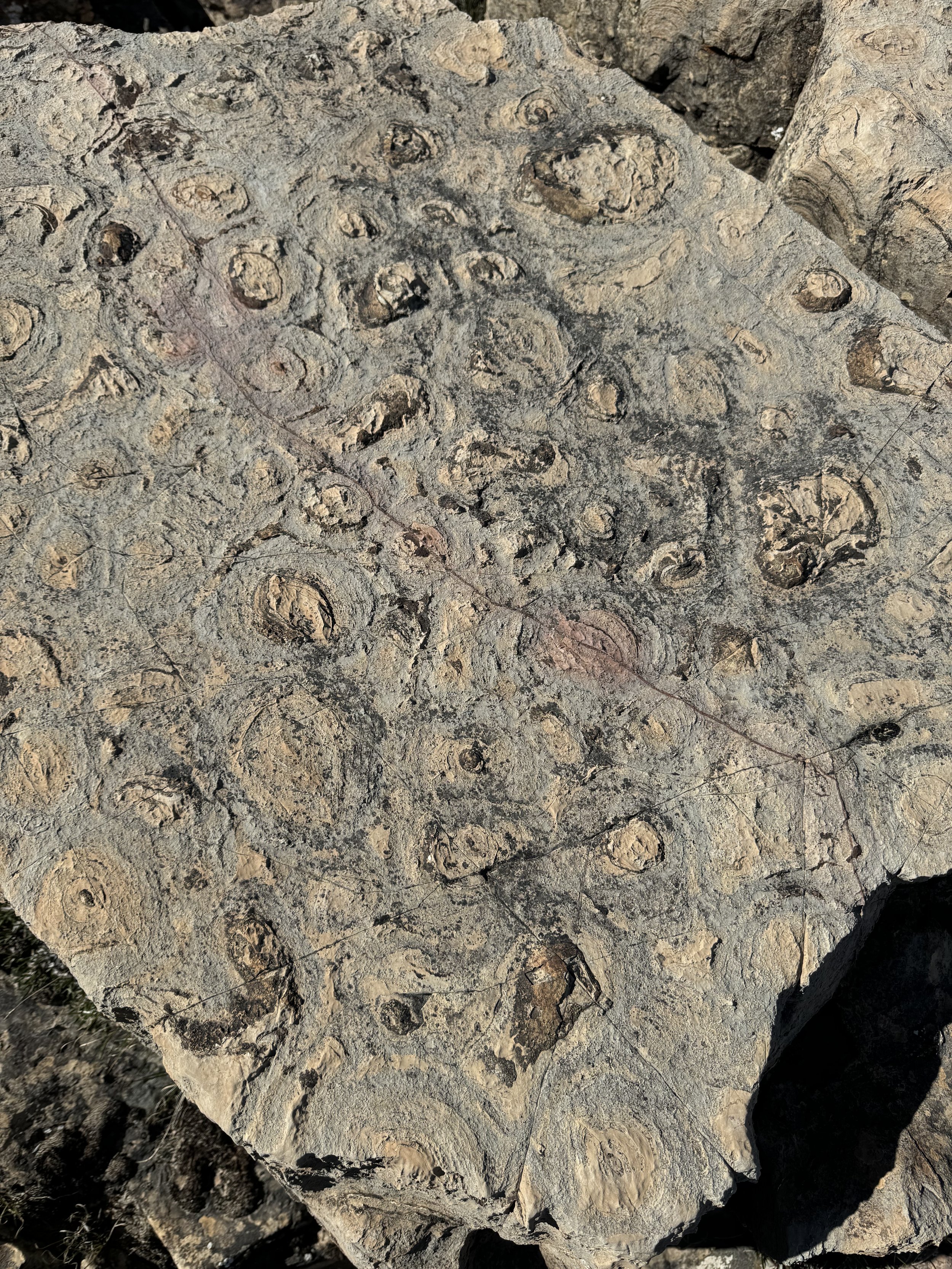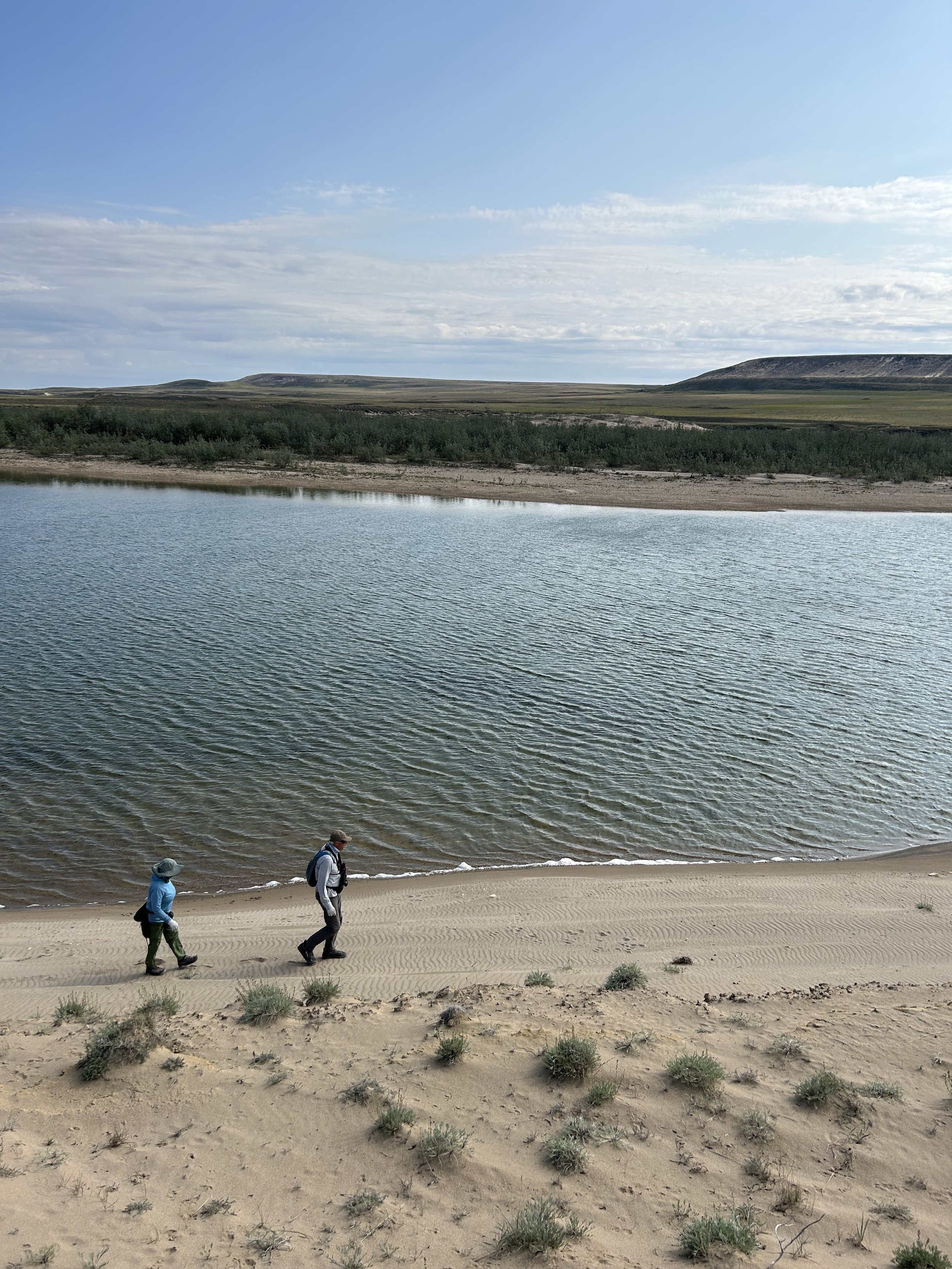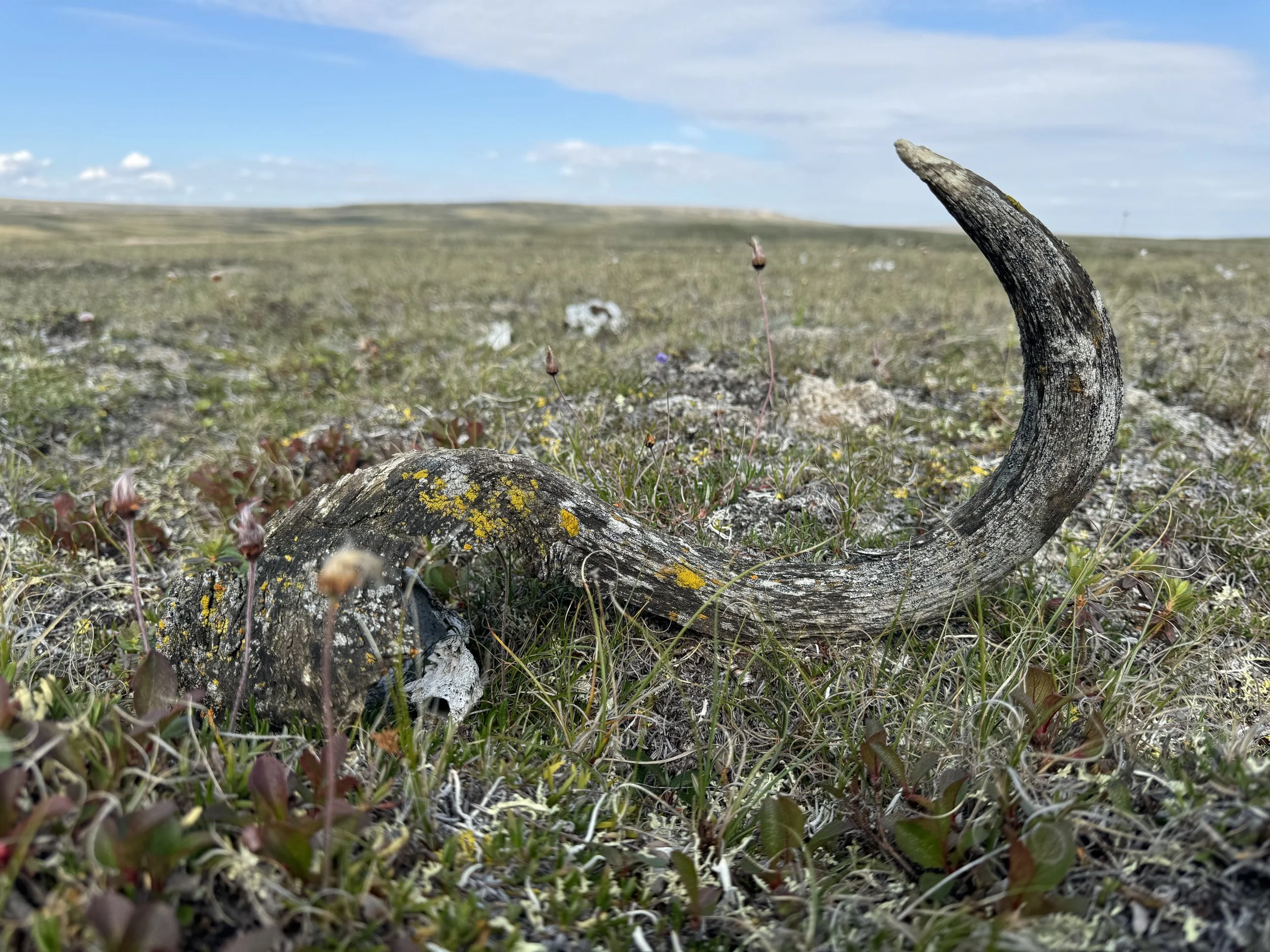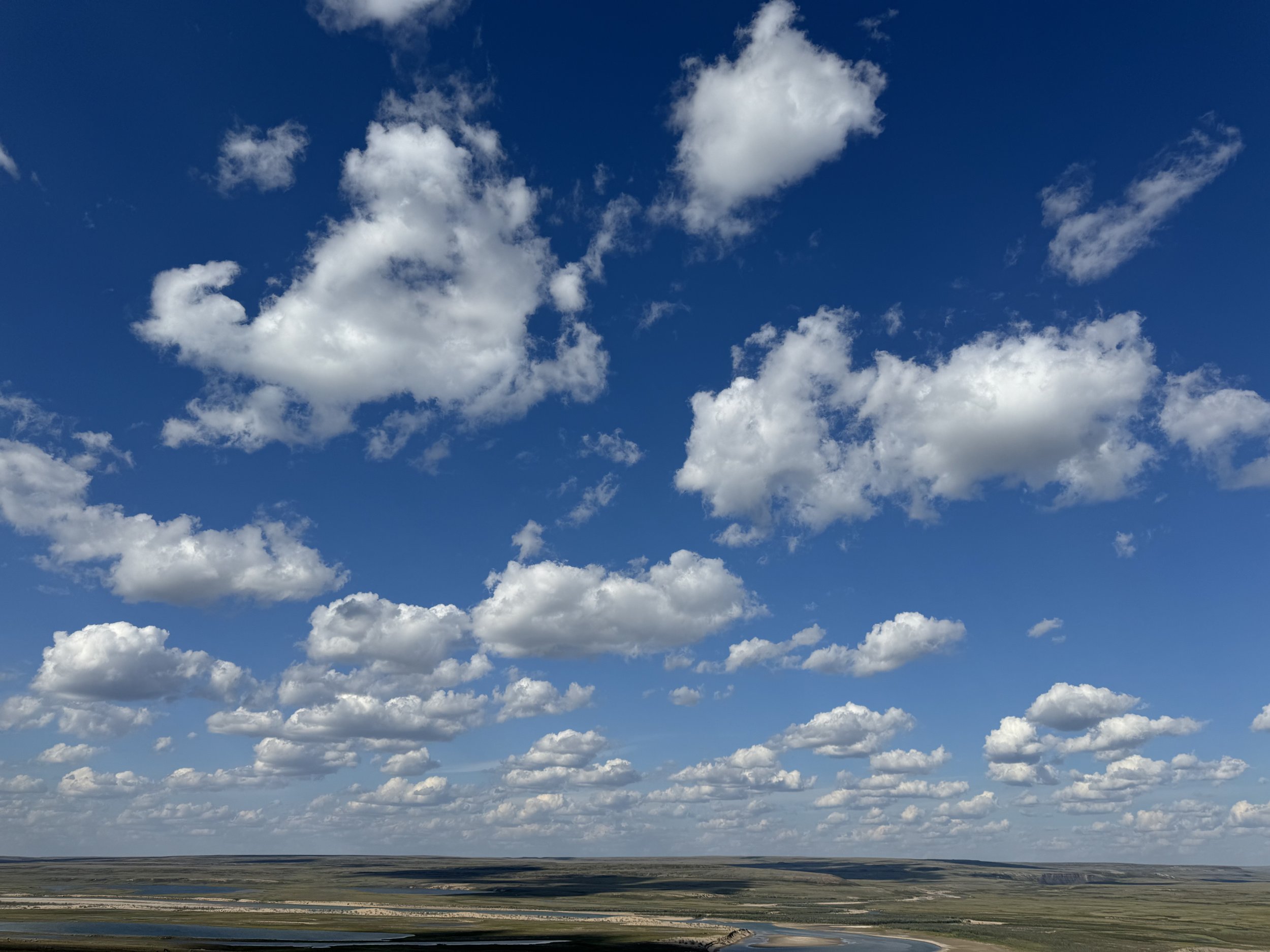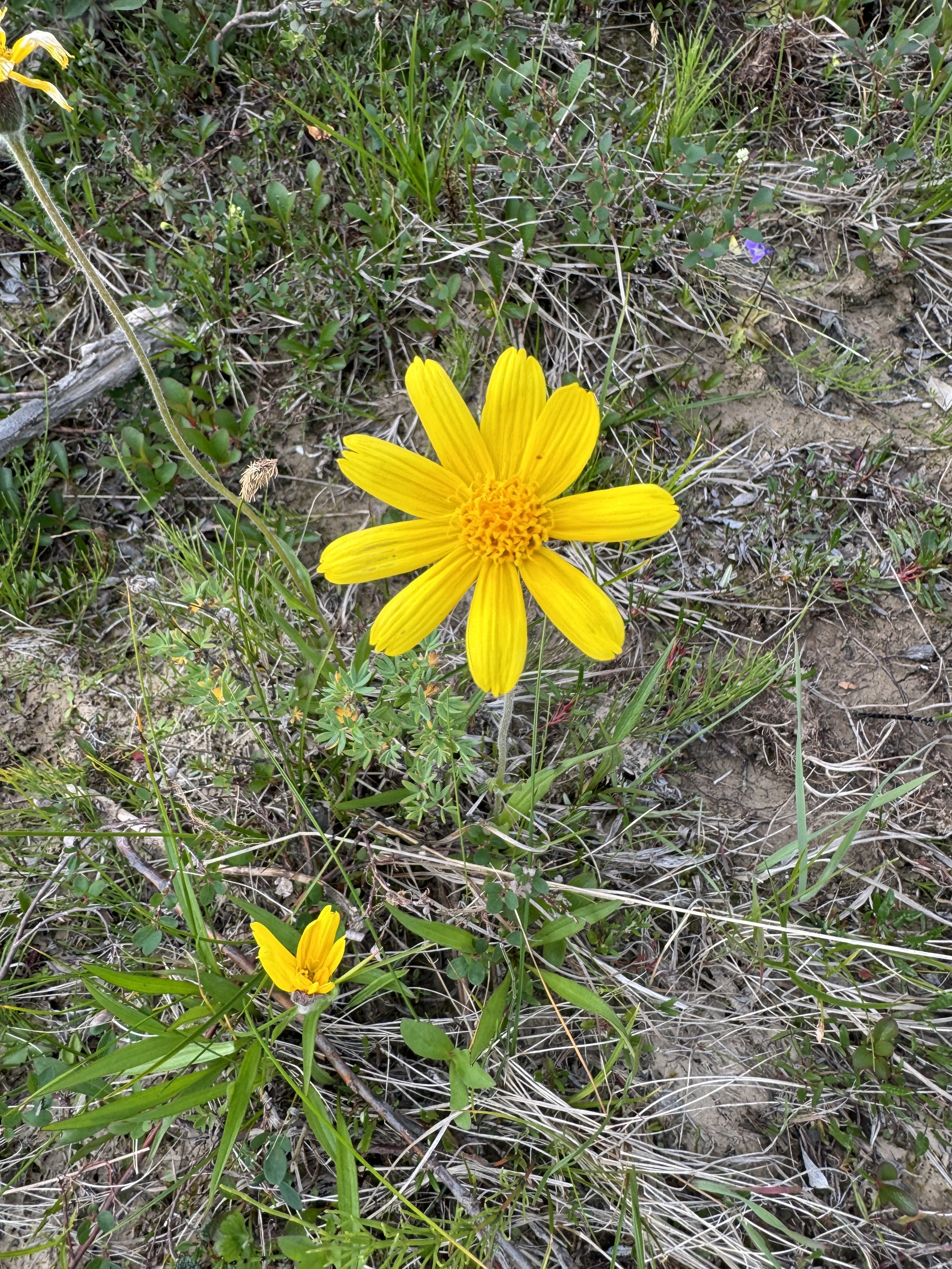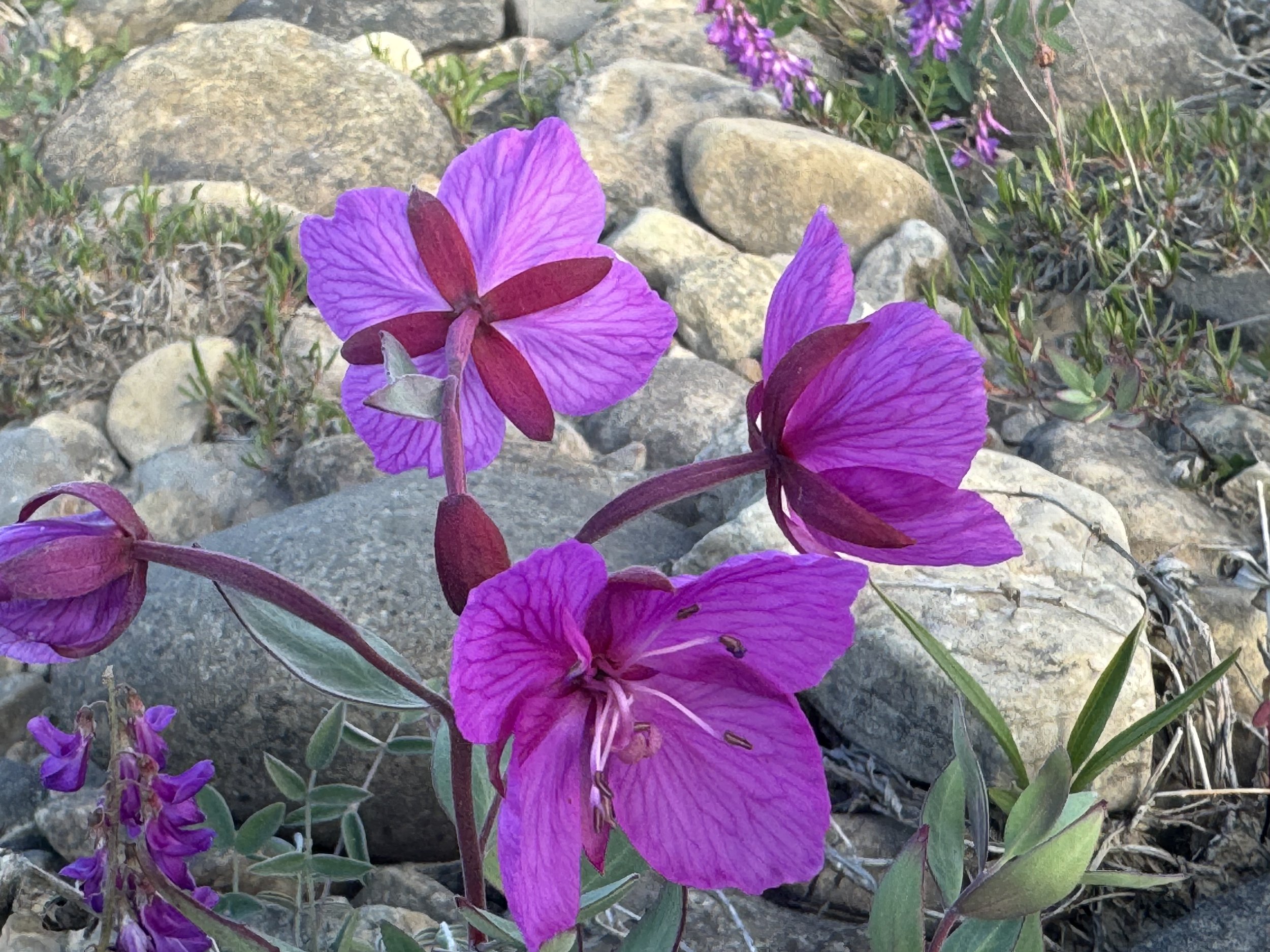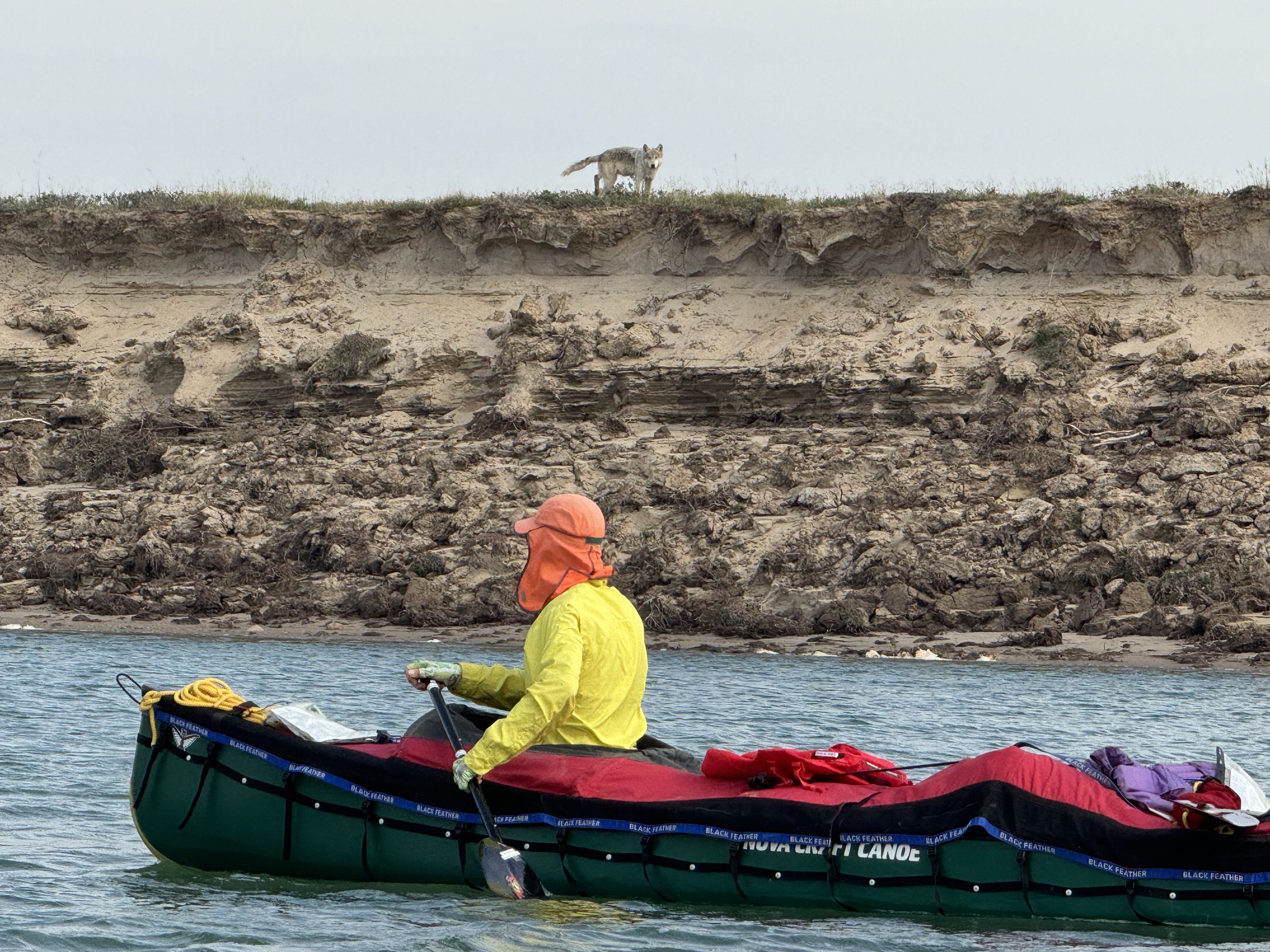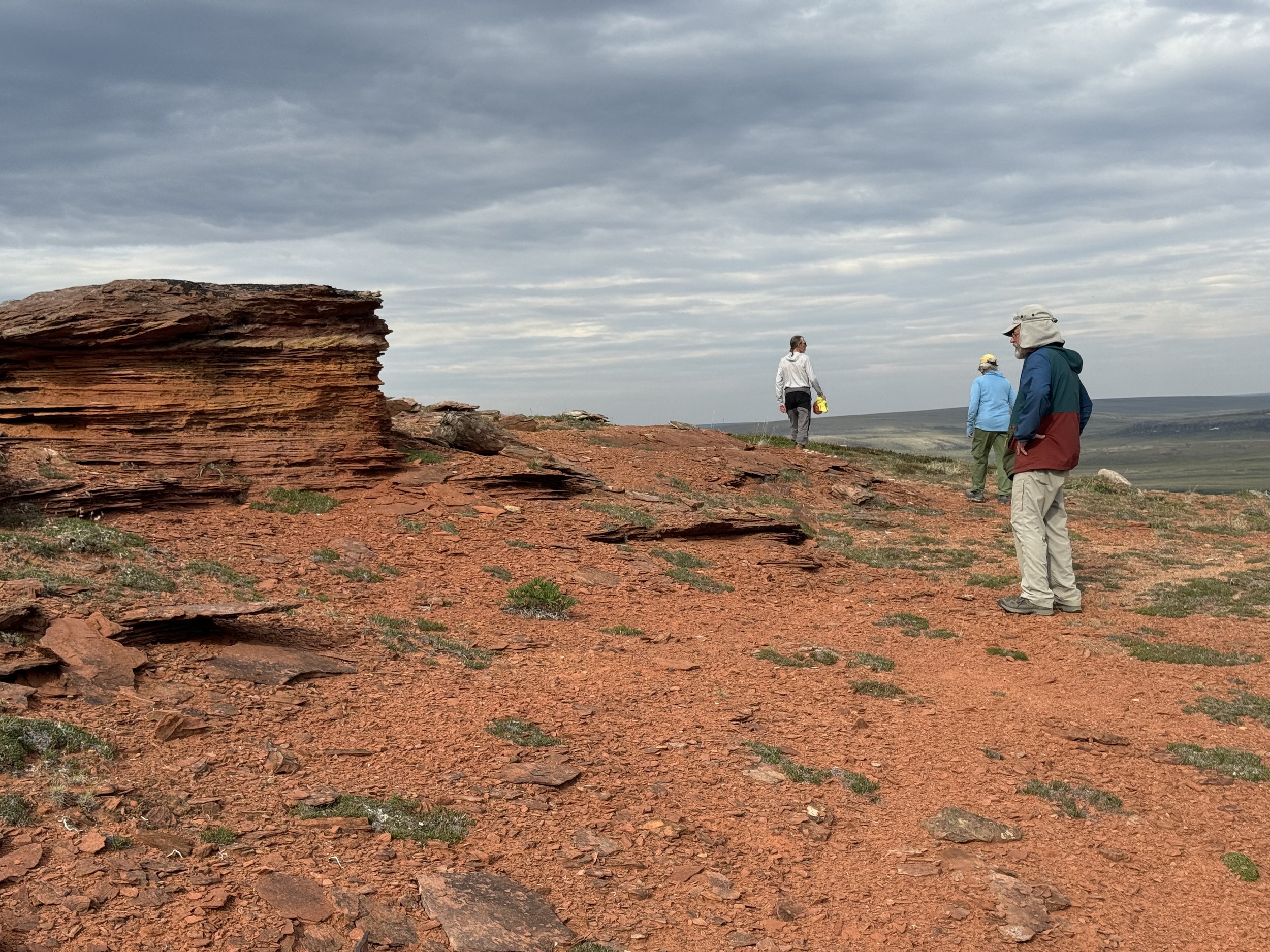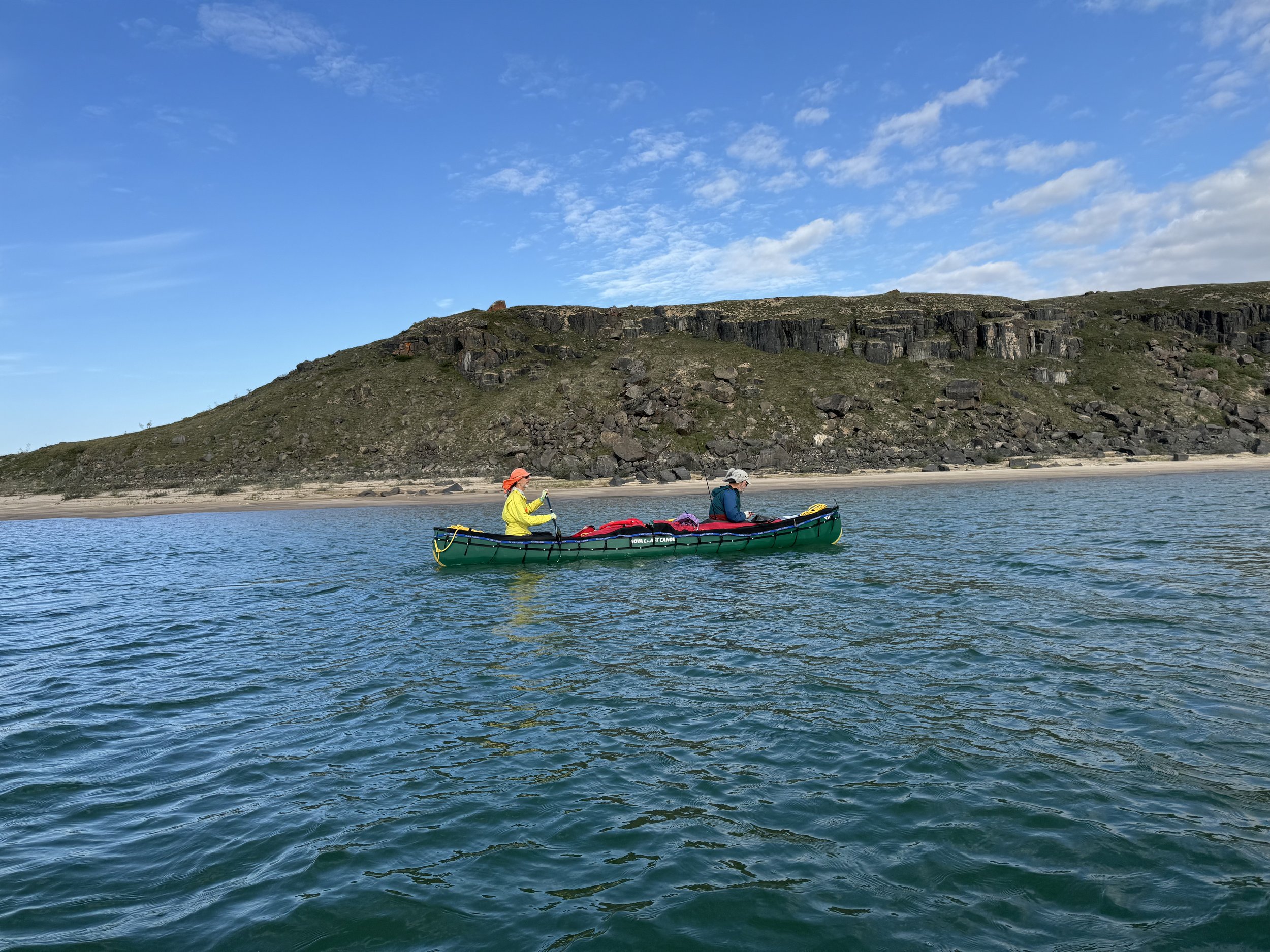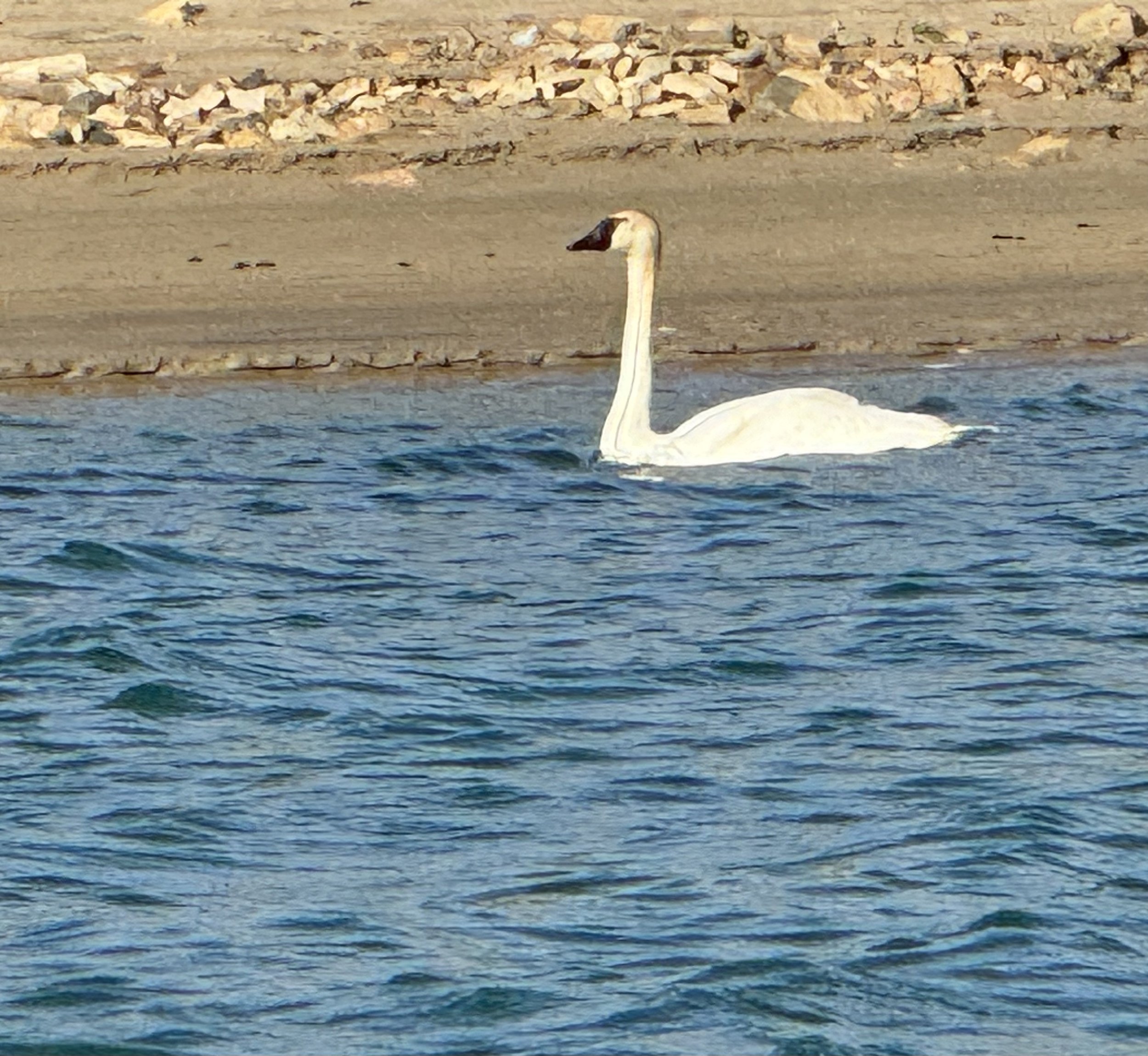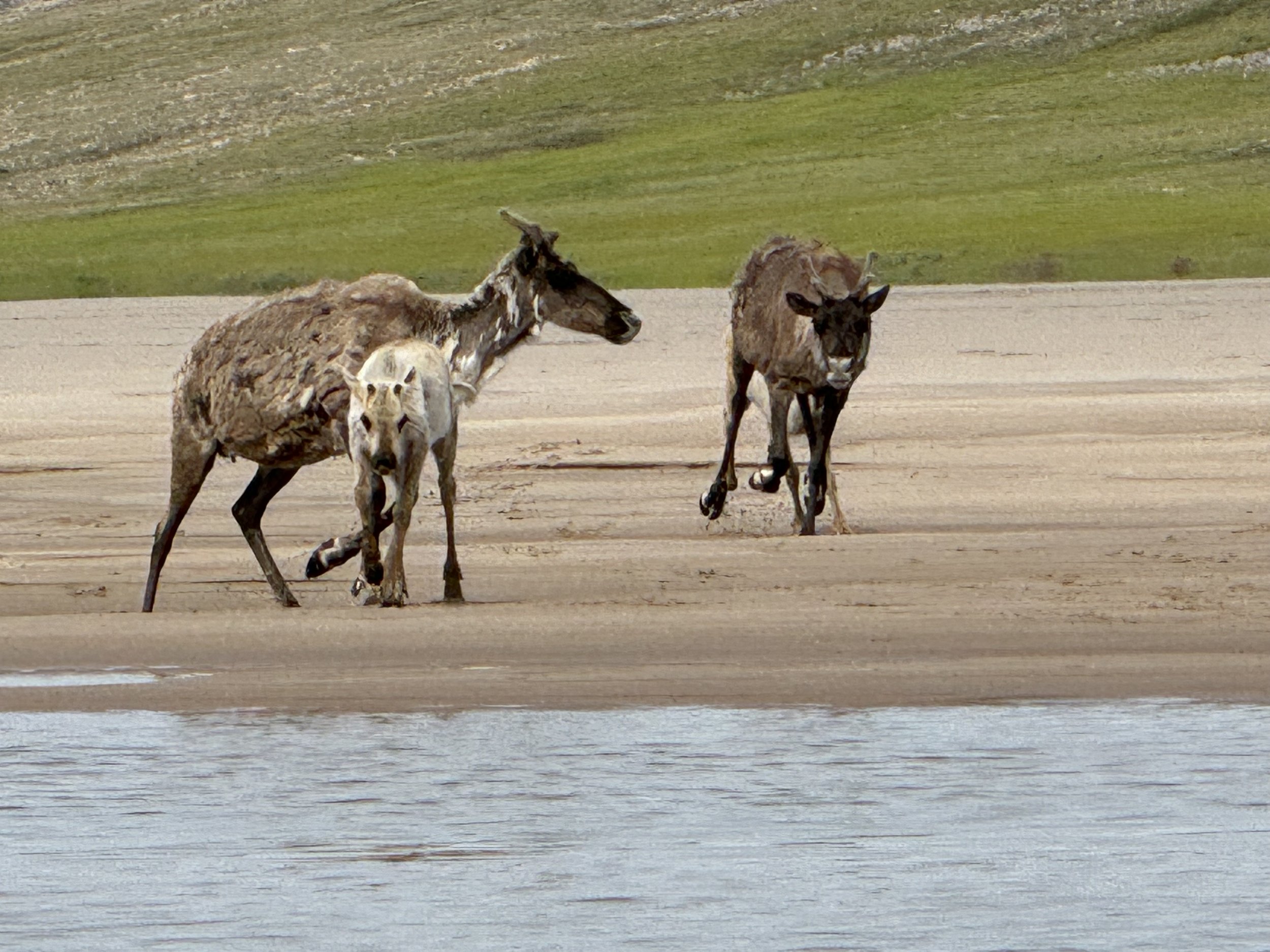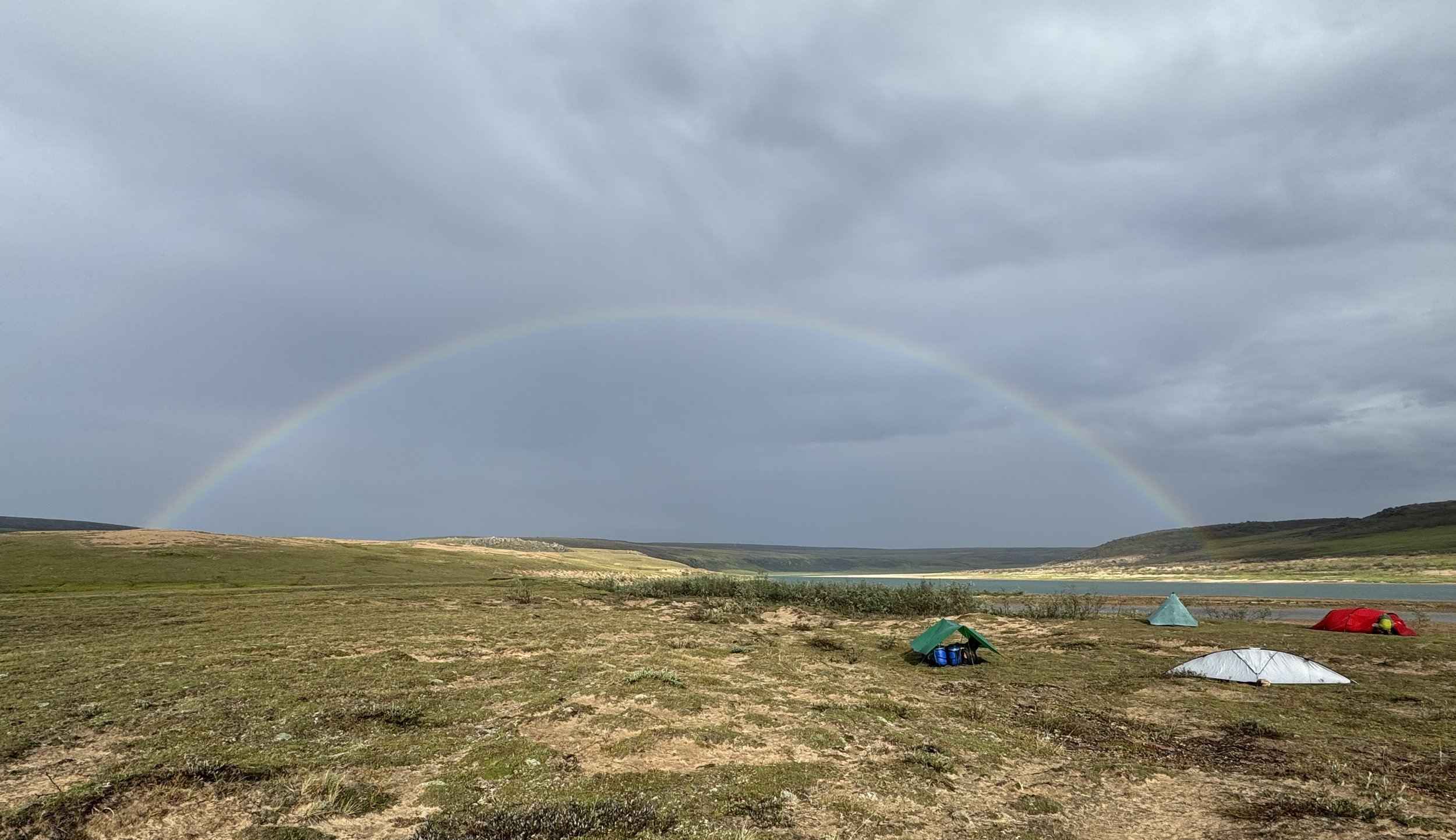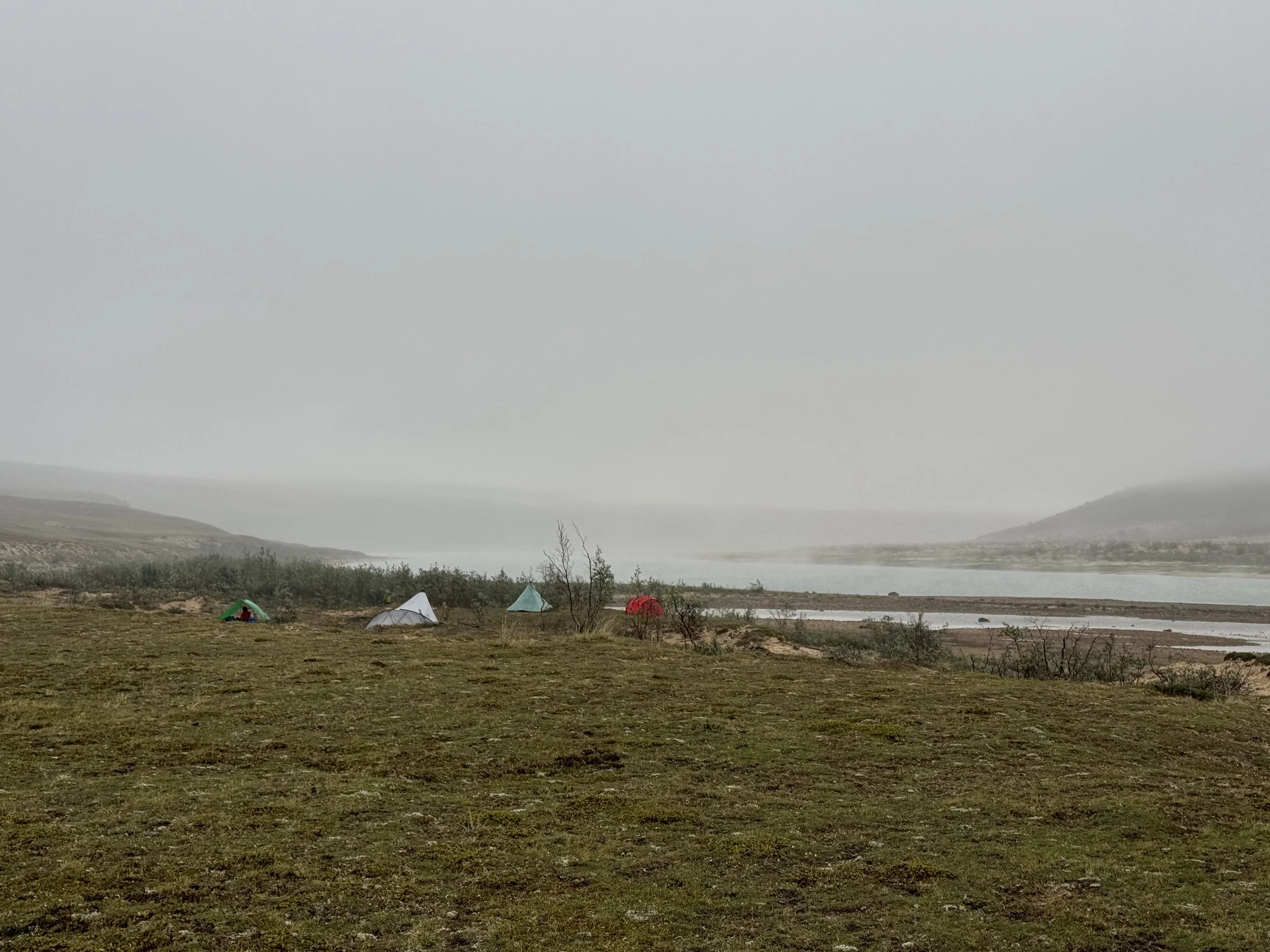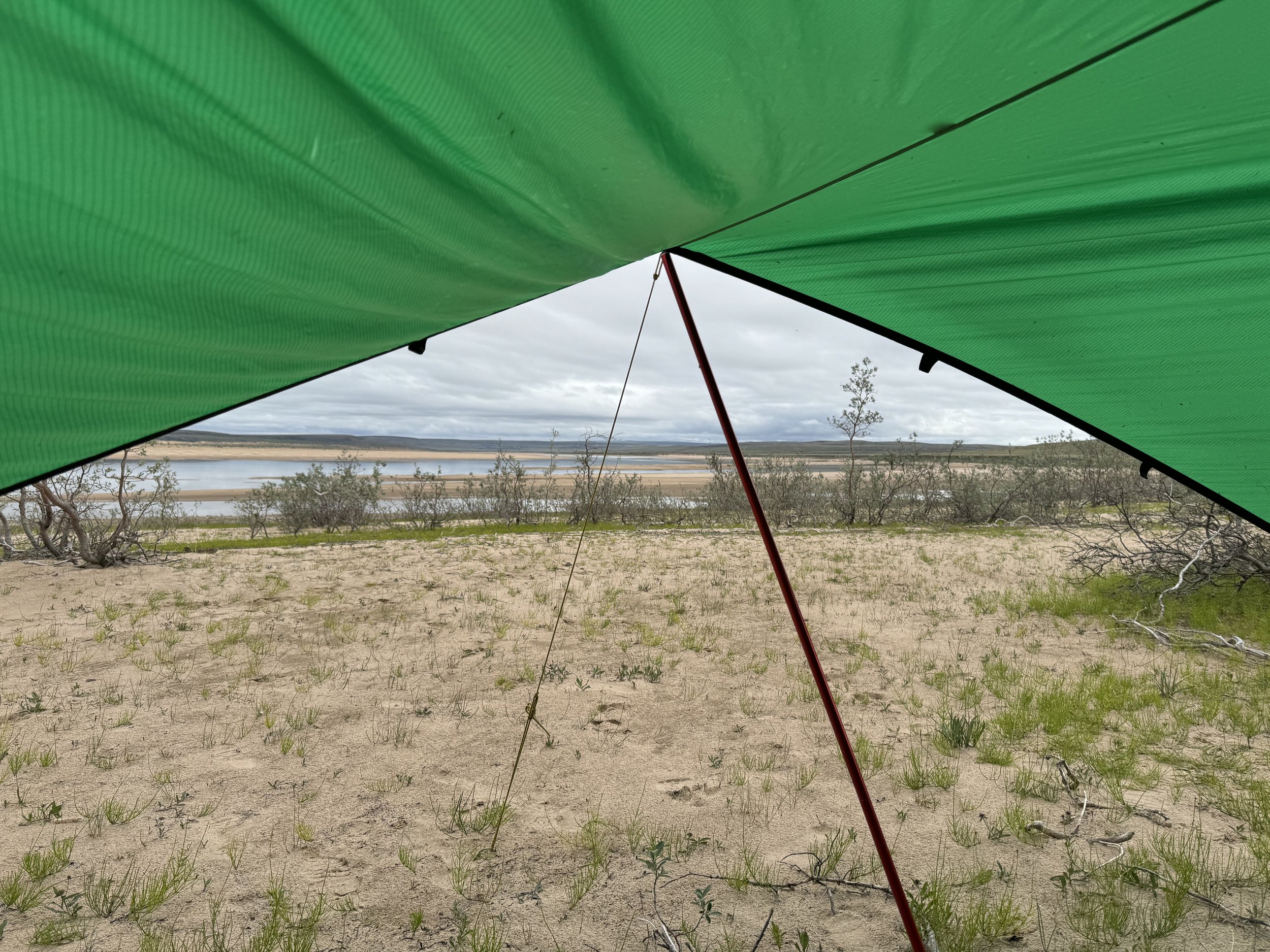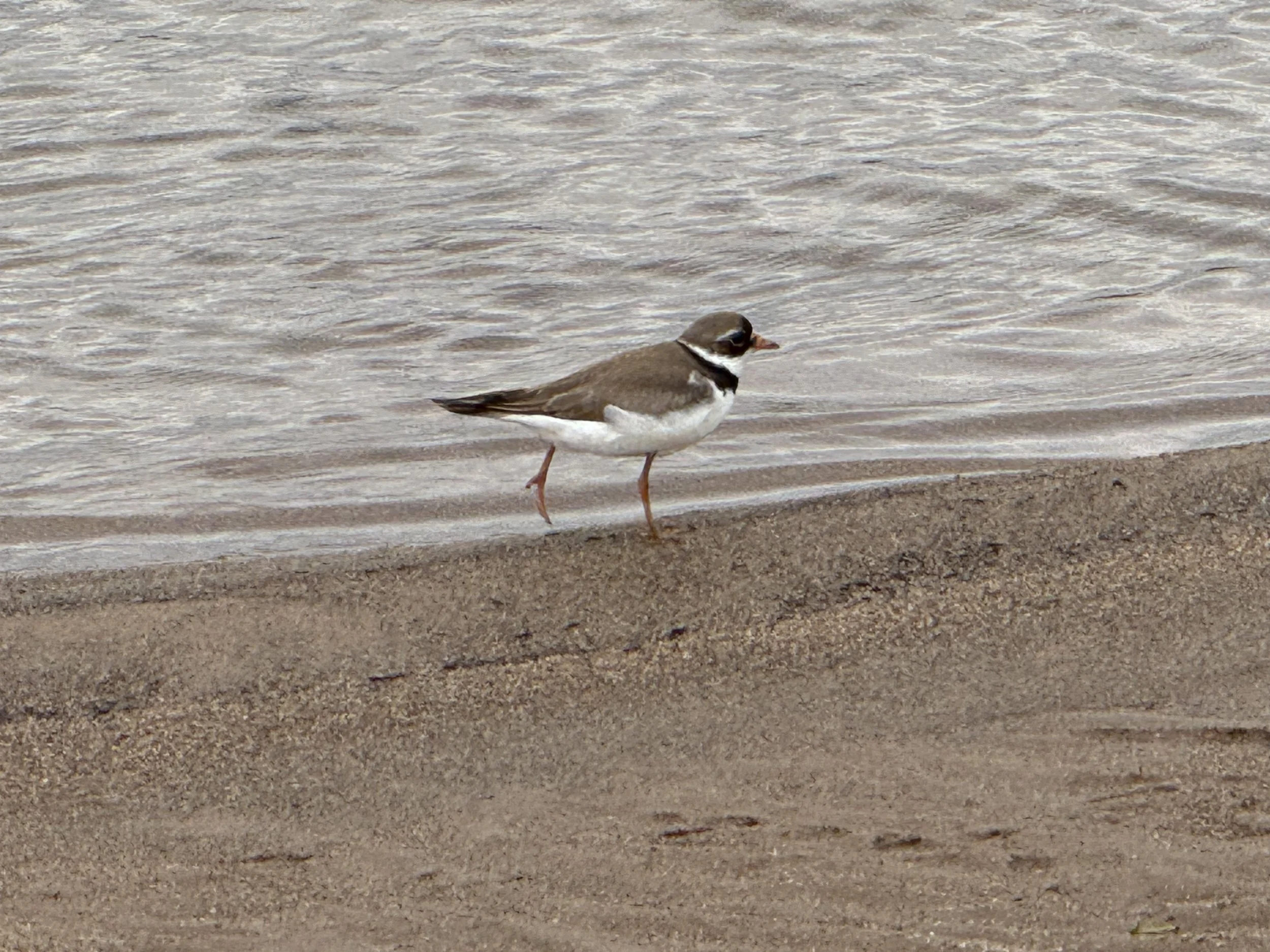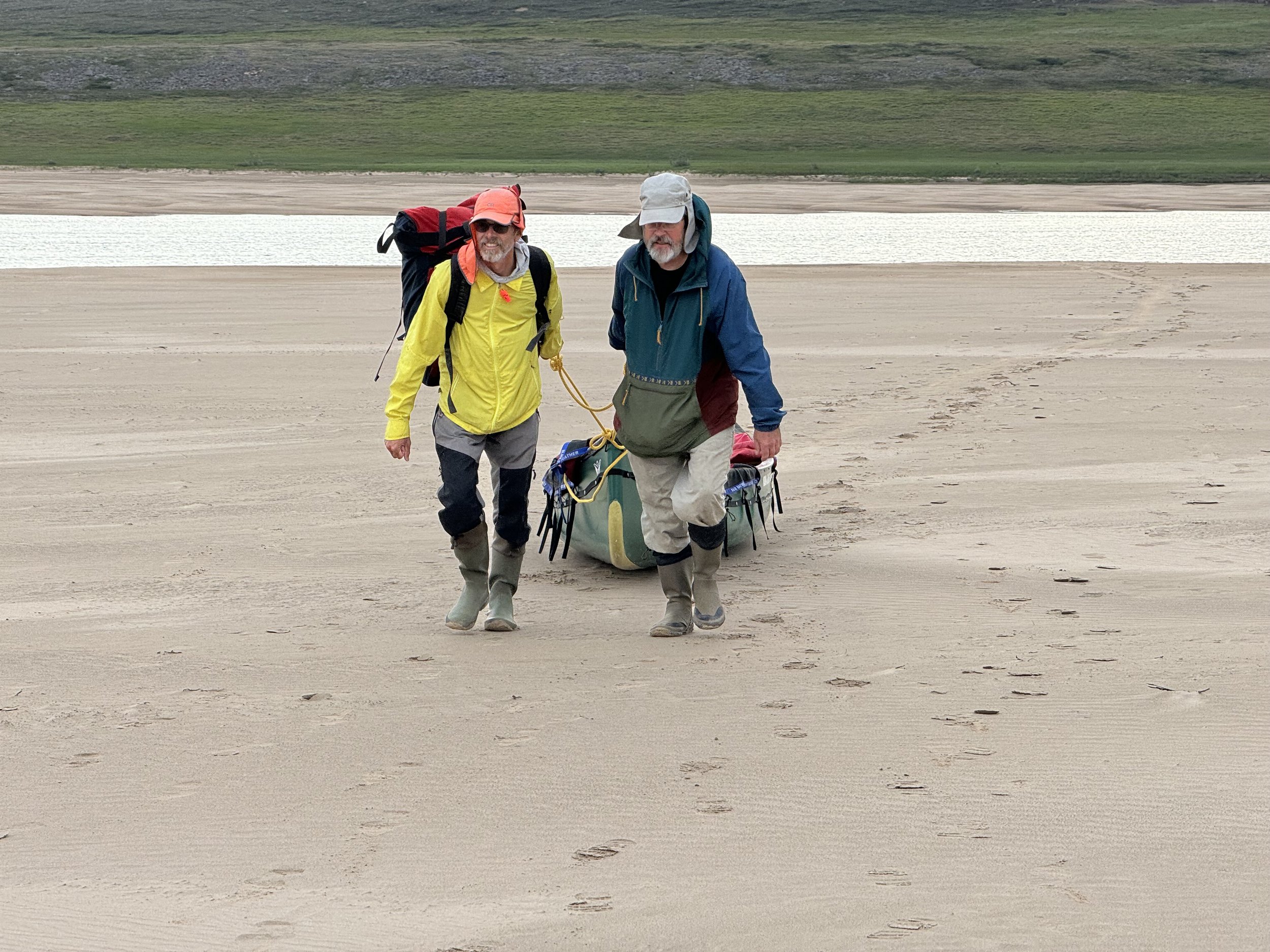July 5
We got a text from Brian and Jim last night that they were on a flight to Yellowknife and would meet us in the morning. Whew that is cutting it close. Glad that they had given themselves a couple of extra days for travel headaches. Glad to report that when we walked into the dining room this morning we spotted Jim and did come catching up during breakfast.
A shuttle arrived and we loaded up with a bus filled with fisherman going to Plumbers Lodge on Great Bear Lake. That is our first stop, but then we will be continuing on.
This map should give you an idea of where we are headed. Locate Yellowknife on Great Slave Lake. It is on the northern arm. From here we will fly on a chartered flight to Great Bear Lake and then load into a single Otter that will transport the four of us and our gear to Hornaday Lake located in Tuktut National Park. It is the yellow part of the map north of Great Bear Lake. The first flight will take about an hour, the second flight will take about an hour and half. The further we go the more remote it becomes!
We arrive to Summit Air, the charter that will take us to Great Bear Lake. All the passengers except for us are heading to the fishing lodge for the week. There are only a couple of females. Most are men who are looking for the fishing experience of a lifetime. This flight only occurs on Friday so if you miss it you are out of luck.
The plane ride will take about an hour. We turn off our phones, knowing that once we get on the plane we will be out of cell service for the next 3 weeks. No complaints from us.
As we depart from Yellowknife, the city is soon left behind and soon the trees will be also. We are spending the next 3 weeks in the Canadian Arctic above tree line. This area is also known as the Barren Grounds or Barren Lands. We fly over a landscape dotted with lakes and rivers. This map gives you an idea of what we are seeing from the plane.
It is a landscape that would be hard to navigate in the summer except for connecting rivers. Winter travel would be easier except for the extreme cold temperatures.
The plane ride is smooth and soon we see the white buildings with the red roofs.
Plumbers fishing Lodge juts out on a small peninsula on Great Bear Lake.
Most of the passengers on the plane will spend the week here hoping to catch and then release (after a photo) the large number of fish that inhabit the lake.
A boat is shuttling clients from the lodge to the airplane that just landed. We wait our turn and then hop on one of the fishing boats that shuttle us to the lodge. Once arriving to the dock we are greeted by one of the lodge hosts. We also meet the pilot who will be flying us to our destination. He is dropping off some clients and will be back in a couple of hours. He shows us where to put our gear and canoes. We have a couple of tasks to accomplish in the next couple of hours. One is to get canoes and spraydecks and the other is to find our bear spray and fuel that was brought here several week earlier on a smaller plane.
Since we are the only paddlers for the summer, we have our pick of canoes. We select two and take them to the dock
While we are waiting for the pilot we use the facility which seems appropriate for fisherman.
Glad they were all encased in plastic.
After a bowl of chili, we are alerted that the pilot is here and we can begin to load the plane.
Our gear
The boats are latched to the floats and soon we are off
The anticipation is building.
The pre trip photo is taken.
This will be the first time that the pilot will be flying to Hornaday Lake so Jim takes the co pilot seat with the coordinates and to answer any questions.
The trees are all gone and the landscape is truly the Barren Lands!
We sit in the back of the plane with our gear. The plane is quite noisy so we were glad to be wearing ear protection.
A group of 10 muskoxen run across the ground spooked by the plane. We can imagine that we could have heard the thundering of their hooves. We are surprised that no caribou was spotted, This is the home of the Bluenose Caribou Herd. A herd that has numbered in the 60,000.
We hope to see some of this herd in the next couple of weeks. The pilot keeps pointing out to Jim that most of the rivers are quite low. Jim assures him that there should be plenty of water in the river we plan to paddle. Finally we see the lake and are glad to see that it is ice free. Jim points out where he has been told of a possible landing site. The pilot does a couple of loops checking it out then lands near a sandy beach. The pilot warns us that we need to stay well away from the propellers and we heed his advice. The gear is unloaded as well as the canoes.
There is a strong wind blowing so the pilot takes advantage of it to move away from the shore. He then turns and soon the floats are lifted from the water. We watch as he quickly becomes a speck in the sky. We are the only group paddling the Little Hornaday this summer. The river can be paddled soon after the ice leaves the lake, which is usually early July. Wait too long and the river begins to drop and you may find yourself doing more wading then paddling. We are hoping that our timing is good. Today though is not the day to figure that out. It is windy and large white caps have formed on the lake.
It is easily to have made the decision to make camp. Tents are put up. Jim and Brian have a shelter for eating called the Mantis.
Don and I have the green pyramid tent, Brian and Jim have the red tunnel tent and the grey shelter is the Mantis used for cooking and hanging out.
The mantis goes up quickly and has mosquito netting for the sides if the bugs are intolerable. Don and I take a look and are somewhat envious. The mantis was created for Arctic trips, unfortunately it has not been manufactured for several years and is no longer available. We have a tarp with a thermacell and hope that it will be the answer to bugs and weather. Meanwhile Jim and Brian make room for us in the Mantis. We are impressed. The decision to stay here today is easy. Paddling in the wind would not be fun and the length of the river is relatively short. We plan to add day hikes to most of our days. We are not concerned with needing to make lots of river miles. After eating we head out to check the surrounding terrain .
The remoteness of this trip is coming real. We have been warned by the Canada National Parks that this is one of the most remote parks in Canada and not to expect any immediate help.
There are tracks of caribou and wolf on the shore. None seem to be recent. We do encounter several birds on our hike
The first one is the young of a Lapland Larkspur. The parents warn us not to get too close.
One can see the downy feathers.
The second bird was a Jaeger. Most likely a parasitic or long tail Jaeger. They are known for their hunting ability. They did several exact maneuvers over our heads.
Jaeger
We are far enough north to have 24 hours of daylight. It has been a long day so after dinner we head to our tents and the wind continues to blow, It seems like we may be here for another day.
July 6 Winded In
The wind blew all night and by morning the decision was made to stay here and go hiking.
The ground cover is quite lumpy. We many be challenged finding flat spaces to set up our tents. The vegetation crunches under our feet. The landscape is often referred as desert like. Rain storms can be frequent, but the land doesn’t absorb the moisture.
Mountain Avens are beginning to appear. Summer is short so the flowers take advantage of the 24 hours of daylight for growing.
Patches of snow cover some of the hills.
It is a quiet afternoon with all of us catching up on some sleep after a busy last couple of days.
Don and I make some brownies to share with Brian and Jim.
Don and I take an evening walk to check out the river we hope to start paddling tomorrow. The wind is dying so that is a good omen.
Checking out the Little Hornaday River
A wolf track on the beach.
We are amazed at the trunk of the willows that grow here. They are 2 to 3 inches in diameter and instead of the branches growing up they spread out on the ground.; It has been awhile that we have traveled on an extended trip with others. Brian and Jim are very competent in this environment so it is enjoyable to follow their lead.
July 7 On the River.
The wind died some during the night. It died enough that by morning it was a go to head to the outlet of the Hornaday Lake and start paddling down the Little Hornaday River. After a breakfast of pancakes and dried fruit we loaded the boats and pushed away from the shore.
It is always a relief when the spray deck fits easily over the packs.
The Little Hornaday is a fast flowing clear stream. There are many rocky obstacles on the river that one must maneuver around as you head down river. We have read a couple of blogs about the river, but there isn’t a lot of information of what to expect. So much depends on the water level as what one will find when paddling. The adrenaline flows as we near the outlet and the current picks up. We are on the river.
It is a cool rainy morning so our extra layers fill good. The weather has eliminated any mosquitoes which we appreciate. The landscape is spectacular as we gaze at our surroundings. It feels surreal knowing that we are the only humans in this area. The first part of the river is mainly fast flowing. Jim has marked the contours on the map with how many feet fall at a certain distance. The steeper the fall, the possibility of more rapids will occur. Brian and Jim are the lead boat and sometimes we feel like a little duckling following its Mother. It is a good feeling and we like having them make the decisions for route finding. Our muscle memory takes over and we feel good about moving the boat around the rocks. The first couple of days is mostly without rapids so that will give us time to practice our white water skills. Finding campsites on the Little Hornaday supposedly is easier than the Hornaday. Today we pass many camping possibilities and after several hours of being on the water, we decide to stop and do some hiking. The hiking possibilities are endless.
We hike up a hill behind camp.
Great view of camp from the top.
Moss Campion adds color to the rocks.
Hanging out in the Mantis
Looking back up the hill from camp.
It will be a challenge to want to go to sleep. The sun shines brightly for most of the night. The battery on my watch dies and Don agrees to hang his watch on our tent pole at night, otherwise I would always want to know if it is time to get up.
Brian and Jim have a morning routine and we follow their suit. We are pleasantly surprised at the lack of insects. It wouldn’t bother us if our mosquito nets stay hidden.
Miles paddled 8.7
July 8. First Fish is caught and the rocks are everywhere in the water.
There is some wind blowing this morning which can make some of the maneuvering more difficult. We find ourselves going from one side of the river to the other to avoid some of the rocky sections. Nothing that we would call rapids, but need to know paddle strokes to avoid rocks. One of the blogs that we read called this river an intermediate whitewater river. We are not sure exactly what that means. The fact that most of the rocks are dark in color and blend in with the water makes the bow person on high alert. Don and I switch positions everyday in the canoe and it is my turn to be in the stern. Don is the on alert bow person. A fun section on the river today was the fast moving S turns. We felt like we were doing a slalom course as the current pushed us quickly from one side to the other.
Brian moves the bow around some rocks.
The day is chilly and the insects are non existent. So far we have had mostly cold weather, our warm clothing feels good.
Below one of the fast moving section is a deep eddy. Jim, also known as the fisherman readies his rod and after several casts lands a perfect size Lake Trout for eating. Don puts some time in fishing, but catching one avoids him today.
We have paddled about the same distance as yesterday and the hiking in the near hills is calling. We find a campsite and the unloading of the boats begins.
It helps to double team on some of the gear. Fortunately the boats can stay closer to the water.
As usual hiking up towards the top of a hill is appealing.
Our tents always looks so far away.
The terrain today on the hike was mostly gravel so the walking was easy. We got up pretty high before we retraced our steps.
A curious caribou checked us out. Earlier today while eating lunch a group of 10 caribou were eating on the other side of the river. Caribou often walk toward us and then as they get closer turn, and with a prancing run and upraised tail take off.
Todays walk brought many colorful flowers.
Always fun to see Lupine.
Loved the patches with color combinations.
An Arctic Ground Squirrel or a Sic Sic (the name that it is given in the Canadian Arctic) also checked us out. There are some Ground Squirrel colonies, but they seem to be rather small. No signs of bear yet and we wonder if there isn’t enough food for them to be in this area.
Sic Sic is the sound they make.
Back to camp where Jim shared some of the Lake Trout he had caught. We all agreed that it rates high on the delicious scale.
Miles paddled 8.7
July 9 Snow and Don catches a fish.
The rain started early this morning and as we were eating breakfast it turned to snow. The consensus was that this would be a good morning to head back to our tent and stay warm. The snow wasn’t sticking on the ground, but it was sticking on the hills that we had climbed yesterday.
I think we had all of our layers on this morning.
Jim gets cozy in his sleeping bag and finds this is a good time to read his book.
Don and I didn’t bring any reading material other than the notes about the river. It didn’t take long to reread them so our thoughts turned to being here in the moment. It was really hard to know what was up ahead. Our weather as to be expected was unpredictable. A quote by Okakura Kakuzo seemed to sum up how we are feeling right now. “The art of life lies in a constant readjustment to our surroundings.” Our surroundings are expansive, every time we go for a hike we feel so small and insignificant. We haven’t seen any signs of recent human activity, but we as we get closer to the Hornaday River there are numerous archaeological sites made by ancient visitors.
The snow had turned back to rain and eventually stopped. After a hot lunch, it was time to pack up and get back on the river. Several large male caribou were near the river, but when seeing us headed up the hillside and were silhouetted against the sky.
There is still rain in the area and the clouds obscure the sun. We pull off at a fishing hole and Jim lands another Lake
Trout.
If this was winter, this is what we would see. a land of white.
Don has success catching his first fish.
It’s a Grayling! Easily identified by the large dorsal fin.
Today has been a day of trying to find the best line for the canoe. We weave from one side to the other chasing the current and deeper water. Sometimes it is easier to walk thru the riffles than try to find a path thru them.
Tonight will be a fish fry with the Lake Trout and Grayling being on the menu.
Jim not only caught the fish, but cooked it up superbly.
Miles paddled 8
July 10 First named Rapids - Signs of early inhabitants
It was another cool night and the sound of mosquitoes were lacking. So far the insects have been quite tolerable, It is another day of picking our way thru rocky stretches.
So many rocks.
We stopped during the day to take a long hike.
We were heading up to some cliffs to see if we could see any Peregrine Falcons.
We found the cliffs but the Peregrines were absent.
On. the way down, we came upon some wood pieces that had be be brought here,
We pondered why they were here and who brought them to this location.
Time for Jim to catch another fish for dinner and then he caught several more as catch and release. Don is still putting in time for fishing and not catching.
This next stretch of river has marked rapids on the map. Right before looking for a place to camp we come upon the Cliff Swallow Rapids. A named rapids usually means one generally needs to scout it. We beach the boats and go check it out..
The first part is a class two rapid with some nice sized standing waves. since we have spray decks, it should be straight forward. We are more concerned what is around the corner. So we walk over to check it out.
Getting thru this section looks tricky and Don and I take the safest option by just walking our canoe.
We find camp right below the rapids and set up our tents. Not far from our camp we find a pile of rocks that we think might have been a cache for storing meat.
From here down to the confluence of the Hornaday River we are looking forward to exploring more ancient sites.
After dinner I make pizza, rolls and cinnamon bites.
It was a relief to have done the first named rapid. The water level seems like it is at a good level to paddle. There isn’t a lot of water which would have made for large standing waves today, but enough to be able to maneuver around the rocks. We always keep in mind the remoteness factor and take the most conservative route.
Miles paddled 8.3
July 11. More rapids and lots of tent rings
The sky was a deep blue when we woke up to have a breakfast of pancakes. Our days of a mosquito free environment is about to be over. We are happy to report that we have a method for putting up the tarp and the thermacell works great with the mosquitos.
This next section is described as having calm stretches interspersed with rapids.
The day is mostly wind free which help[s when we encounter rocky sections. The Little Hornaday is quite clear, In a couple of days we will be paddling the Hornaday which is characterized by many sand bars and cloudy water.
Brian is our map expert, but we do have GPS if we need to pin our exact location.
There seem to be more rapids than what the map says. Our boat follows the lead of the green boat.
Dark rocks add to the challenge.
A long hike during the day, once again gave us vistas in all directions.
A high point of the day was finding numerous tent rings along the river.
Again we have lots of questions about the people that lived in this area.
A peaceful evening with a planning section of how we were going to go thru this next set of rapids.
Miles paddled 9.1
July 12 Hottest day yet, more hiking and Stromolites.
The sun shone brightly and warm on our tent as we emerged for breakfast. With the heat and little wind, the mosquitoes have made their presence known. We are happy to say that the thermacell under the tarp works magic for eating in peace.
We have added some light weight chairs to our camping set up and have been enjoying the comfort of not sitting on the ground.
We ferried across the river to take advantage of hiking up to a summit.
I hiked with my umbrella.
The view as usual was spellbound as we looked at the river running its course.
Back to the river to load up and head down river to look for fossils.
Arctic explorers
We had the fossil location marked on our maps and then near that location some different rock formations were sighted.
We beached our canoes to get a closer look. We saw many of the fossilized formations called Stromatolite.
Sromotalites
Later when we were visiting a museum in Yellowknife we read this description.
We continued down the river usually paddling thru the rapids if feasible. Sometimes though Don and I decided it was much easier and safer to walk when the river was shallow and had numerous rocks
On our map there are oil drums marked and we see them from the fossilized site. Brian and Don go check them out. Not a pretty site and we wonder what is the story behind them.
A bit of a scar on the other wise pristine landscape.
The wind has picked up and more clouds are moving in. We make a tight camp tonight in case we get a storm. It was a short day of paddling, but did several shore excursions. We have planned to spend more time on the Little Hornaday as the fishing and hiking opportunities are greater than the Hornaday.
Miles paddled 4
July 13 First sighting of the Hornaday River
Since we are having a couple of short paddling days, we decide to do a hike this morning to the tallest point that is near our camp.
Easy to choose a path.
Taking a break on the summit and surmising where the confluence of the Hornaday is located.
We returned to our boats, loaded up and pushed off. Each turn of the river having minor rock avoidance challenges. We chose either to bump down the river leaving red and green marks on the rocks or occasionally hopping out and walking the boat. We don’t get graceful points for the hop out. We like the spray decks, but especially Don with his long legs often isn’t the quickest out. We really only had one incidence when he was slow to get out and the boat turned stern first and we had to do some tricky steps to realign it for the bow to go first. We found a nice spot in the boulders for lunch and then arrived to our camp about 3;30.
At camp we take time to take baths and then Brian, Don and I head off to check out the sand dunes and get a feel for the different flowing style of the Hornaday. Tomorrow we will join up with it and instead of rock avoidance it will be picking the right line thru all the sand bars.
We head in the direction of the Hornaday and are surprised to see a lonely willow tree in the distance. It is the first bigger tree that we have seen. As usual we touch the bark to get some of its energy.
We can only imagine how old it is.
As we approach the river, we are walking on sand dunes. This is definitely a new environment.
There is more vegetation and more birdlife than the Little Hornaday. Don using his Merlin app that identifies birds with sound, picks up the song of the Common Red Poll. the Yellow legs and the American Golden Plover. All seem to have nests nearby as they warn us of not coming too close. Warning us was not adequate enough for the Arctic Tern.
As we were walking along the shore, we noticed a fluff ball moving near us. It was a baby Arctic Tern. Their parents quickly began dive bombing us and we could see their beaks moving rapidly as they drew close. Not wanting an encounter with that sharp beak, we quickly moved away giving the adult birds and their babies plenty of room.
Several flowers were peaking thru the sand and we wondered how they survive when the sand dunes cover them up.
Gentian
Grass of Parnassus
We also came upon low bush cranberry that were just beginning to ripen.
On the way back to camp we walked by the skull of a Muskox. I was surprised at how heavy the skull was, probably weighing close to 35 pounds. Can clearly understand why you wouldn’t want to get head butted by one of them. Nearby was the horn.
Muskox horn
Miles paddled 5.3
July 14 Hornaday River , Don catches a Lake Trout
Today if all goes as planned we will be at the confluence of the Little Hornaday and the Hornaday River. We got a feel for it last night during our hike. It will be a different paddling experience. Right before the confluence there is one more rapid for us to go thru. There are nice eddies on both sides of the rapid so I suggest that we should stop and Don should try a couple of casts.
Don yells “Fish On” and soon there is a nice sized Lake Trout on the shore.
The smile says it all.
Soon after leaving the fishing hole, we round a bend and are presented with the slow flowing and wider Hornaday River.
Definitely a new landscape.
The clouds increase during the day. The terrain is a lot flatter than the Little Hornaday.
Often huge sand bars occupy both sides of the river. We search for the darker blue water that usually will be the best channel. The wind is behind us which makes us happy. We have been warned that a wind from the North will slow your progress down considerably almost to the point of not making any headway and most likely needing to take a break until the wind shifts.
A short section of Hoodoos comes into view.
With the water mostly being knee deep, we have removed our lifejackets to cool us off. This is the warmest day yet.
The current is quite a bit slower so it takes more effort to paddle. Sometimes it feels like we are on a lake rather than a river. At least we have wind to our backs. Our lifejackets are taken off soon after this photo was taken.
During a break, we check out a couple of the colorful flowers on the shore.
Arnica
River Beauty or Dwarf Fireweed
The river takes on the color of sand and is often only 3 to 4 inches deep.
A lone caribou checks us our as we paddle by it.
Jim and Brian are the lead boat and therefore the campsite selectors. They also switch seats each day and who ever is in the bow gets to go and determine if the site will work for our tents. When the hands up are given in a V formation we know that home for the night has been found. Today we checked several sites before settling on one we think might work.
The ground is quite lumpy which may be why the Hornaday is not known for having great camping sites. After putting up the tents and inflating the thermarests, we hope that our mats will equal out the lumps. That didn’t really happen and we spent the night trying to get comfortable between the lumps. Tomorrow if possible, we will be more careful of our campsite selection.
Don and I take a short walk while Jim cooks up a feast of a mushroom stew with wild rice that he has harvested from Minnesota. We cook up the fish and celebrate the fact that we had made it thru the rapids of the Little Hornaday and now are on the Hornaday.
We put a stick in by our canoes tonight to see how much the water goes down overnight. Usually one can only paddle these rivers during the month of July. Seeing how shallow the river is in places we understand that if it goes down much more, one would be dragging their boats over the sand.
Miles paddles 13
July 15 A wolf encounter
We awaken to another beautiful day on the river with a slight breeze on our backs. Life is good! Our first stop of the day is only an hour away. In one of the posts that we had read, it told of an active Wolf Den. The blog was written two years ago so we were not sure that it will be currently active. The den was described as being about a 20 minute walk from the river. In the distance we can see a slightly raised hill and head in that direction. We look for signs of tracks and scats, but don’t see anything until we approach near the hill. As we get closer to the hill more track signs are sighted as well as scat. Brian picks up a stick as he peers over the hill into one of the many entrances.
Don follows his lead and finds another fragile willow branch.
I don’t have much faith in the strength of their weapons.
There are bones scattered about, but again not fresh looking.
I take a closer look at one of the entrances and also don’t see any evidence of this being an active den.
Then we hear a howl in the distance and as we turn to face where the noise is coming from we see a very small object in the distance. There is a continuous howl and we decide that we need to back off and quickly, (but not run), and begin to head back to the boats. We glance behind us and see a rather large wolf gaining on us. We also spot another one slightly behind it. As we continue to walk the gap between us narrows.
We have a quick discussion and when we approach a small hill we all turn and face the wolf. It stops and sniffs the air. It then starts to walk toward us again, but slower. We turn and continue walking and the wolf follows but not as close as before. Don and I haven’t had a wolf encounter like this before, but Jim and Brian have had similar experiences. They seem confident that the wolf is just curious. I hope they are right, Finally we get to the bank and head down to the boats, loosing sight of the wolf. Just as we push off and into the river, the wolf appears at the top of the bank.
The wolf follows us for almost a mile, marking as it goes.
Finally it gives one more look and then off it goes.
Another fun sighting was that of two Peregrine Falcons flying closely overhead. It was amazing to see the speed at which they could dive and then recover. We kept a lookout for nests, but none were apparent. We also saw a large group of goose young who were challenging their parents who were trying to keep them together. They were so well camouflaged that none of the photos turned out. About 3 we stopped to make camp and made sure that we found a campsite with a minimum amount of lumps. After dinner we did a hike recommended by the National Park called Red Rock Rising .
It was obvious how the hike got its name.
We were happy to see a clear water stream running into the Hornaday. The water in the Hornaday isn’t bad, but if we can find clear water streams we try to fill up our water bottles.
The wind shifted as we approached camp. We may have a headwind tomorrow.
Miles paddled 13
July 16. Revenge of the mosquitoes and Caribou babies.
The mosquitoes were out in full force this morning, making enough buzzing noise to wake me up. Glad that we have our systems figured out for eating in peace. We had a morning of pancakes smothered in dried fruit and applesauce. There was a slight headwind, but the temperature was great.
In this section the river got wider and the sandbars huge. Sometimes it was difficult to determine where the sandbar ended and the river kept going. It was also challenging to determine the depth of the water. It was the realization that you are stuck on the sand and when you hop out you start sinking. Sometimes the right way was only inches away from getting stuck.
We paddled thru a section of rocky cliffs made orange by the lichen. The landscape was always changing.
An abandoned eagle nest had an impressive array of sticks.
A peregrine falcon was seen perched high on the cliff.
Several trumpeter swans hooted their way down river.
We were headed to a hike that would take us up to Look Out Mountain. We figured with a name like that we should have a great view. We looked at the mountain and came up with a plan to hike to the summit. The first part of the hike was a maze of trails made by caribou going thru small valleys that had been created by water erosion and ice flows. Eventually we made our way thru and worked our way up to the summit, which provided us with 360 degree views.
Numerous rocks were covered with this orange fungus or lichen.
We took a different route down and avoided the maze.
But had to cross a tricky section of tussocks and swampy areas
Concentrate or one would end up with very wet feet or even slip and get all wet.
Some of the hills and shorelines are covered with cotton grass.
Cotton Grass
It was a short paddle from the hike when we noticed a couple of caribous. That turned into many more as they seemed to be gathering on the sandy shores. There was a slight breeze and it was obvious they were miserable with all the insects. Their whole body would quiver as they tried to rid themselves of the biting insects.
There were quite a few adult females with their young. It was interesting to note that the females didn’t seem to keep track of their babies very well. They would take off and the babies would run behind them trying to keep up. Several young caribou were seen just lying in the water panting from all that running. We saw a young calf on our hike that was lost. When we came back from the hike the young caribou was just running up and down the beach looking for its Mom.
It was an interesting comparison when we thought back to an earlier encounter today with a duck and her flock. There were about 6 or 7 ducklings following the Mother when one got way behind. The Mother duck stopped and kept quacking until the young one made it to the group and they continued on.
Leaving the caribous, there was a calm feeling on the water, but a feeling that a storm could be approaching as the sky was becoming dark.
We picked up our speed hoping to make camp before the storm hits. Fortunately the first site we looked at, had some good spots for tents. Our camp was set up in record time. It was a good thing as soon as we had set the last stake the thunder echoed across the sky, then came a hard rain. Don and I set up our canoe barrels and canoe bags for a wind break under the tarp and also used our umbrellas to break the force of the rain that was now being blown sideways. Between cells that moved thru, I was able to take a couple photos of our camp.
Using our canoe barrels as a wind break.
And then there was a rainbow.
We managed to cook dinner, then drop the tarp so the wind wouldn’t damage it and then weigh it down with our packs. We drop our tarp each night for reasons that we won’t have to deal with a tarp in the middle of the night if a storm moves in. Jim and Brian also do the same with the Mantis. We had several major rain falls during the night as the storms moved over our camp. Our warm days may be a thing of the past. The storm has brought a major drop in temperature. In the tent we reflect that being unplugged from the world feels great.
Miles paddled 15.8
July 17 Cold windy weather. the last rapids of the trip
The blue sky of yesterday was gone replaced by a low cloud cover.
Fortunately the rain had stopped by morning and we were able to pack up our packs when our gear was somewhat dry,
Back to wearing most of our layers. The wind is now coming from the North which means our forward momentum will not be the easiest.
At least paddling hard, makes for a warmer day.
There is one more set of rapids that we will encounter on the river.We hear it before we see it. Scattered across the river is lots of rocks creating a challenging obstacle course. Brian stands up in his boat and looks for a way thru. We follow his lead and make it thru without many bumps on the rocks. When there is rapids, there is current and for awhile we get to pick up some speed. Not a lot because with the wind it balances our the current. We are thankful that for the first couple of days on the river the wind was behind our backs.
Most of the scenery is obscured by low cloud cover, but close to the shore the cotton grass is in full bloom.
We haven’t seen any caribou today and we are thinking that perhaps with the drop in temperature the mosquitoes are not as bad. The caribou don’t need to be close to the water for a breeze, but are hiding out in the willow trees. Soon the caribou will be gathering into a large herd to begin their migration. Yesterday we heard a small plane and watched it do circles to the north of us. One explanation that we had was that perhaps they were checking on the herd. We were hoping to see the herd migrate, but that may not be our luck for this trip. We are satisfied with the encounters that we have had.
At lunch we talk about a plan for getting to the Canadian Park cabin where we will stash our canoeing gear while we do our hike. If the weather cooperates we should be able to get to the cabin tomorrow and either leave for the hike later that day or head out the next. We plan to try to camp about 5 miles from the portage tonight. The portage will take us in to a lake that has the location of the cabin. The Hornaday River flows into a canyon with class 4 and 5 rapids. One needs special permission to attempt it. There have been only several groups that have attempted the canyon .Most if not all have used pack rafts. Brian has the skills to do it in a proper boat for the conditions. The rest of us probably not.
By mid afternoon we are on the look out for a campsite. We have stopped several times and have not found one that will work. A marked site from another group appears to be quite difficult to get to now. The sand bars have shifted and the river has taken a new course. We decided rather than try to camp here we will move on. Not to much farther, we come on a site that has hard packed sand on one level and tundra on the next level. The tundra is not exactly lump free, but Jim and Brian find a spot that will work. Don and I don’t like the idea of camping and eating on sand, but there is enough vegetation growing on the sand that we are ready to give it a chance. We set up our tent and shelter and comment that this may be the most flat space we have encountered. Being extra careful we make Pizza and bread. After Dinner Brian and Don hike down towards the portage. It is not a marked portage, but one that you find that works for you. It involves crossing a sandy beach into a river coming from the lake with the cabin.
We know that a group from the Canadian Park Service has been on the Hornaday this summer and probably portaged somewhere along the beach to the river. Don and Brian looked for footprints but none were to be found. They did determine a general area that we can portage across tomorrow.
The view from our kitchen.
Tomorrow our goal is to get to the cabin and switch gears for backpacking.
Miles paddled 13
July 18 Portage and winded in
Last night we had the flattest ground of the whole trip, I guess sand camping has its advantage.Don said that we had quite the rain storm, but I didn’t hear a thing! By morning the rain had let up and our tent and tarp were almost dry.
This Semipalmated Plover had a nest nearby. It was always trying to have us follow it. We assume to keep us away from its nest.
It was a short distance to the portage, but even in this short distance we found ourselves going from one side to the other to find a path thru the sand bars.;
The weather seems unsettled, we may not make it to the cabin today.
We landed on the shore, hoping that we had found the shortage distance that would take us to the river. We took a load of gear to leave on the other side.
This is the only portage of the trip.
On the first trip to the river, we spooked a small bird laying on eggs. On return trips we were glad to see that the bird had returned to its nest. We gave it a wide berth.
After the gear was taken next were the boats. None of us wanted to portage the boats on our shoulders so we developed a system to pull them across the sand.
It was much easier for the four of us. Brian is in the back.
Overall the portage only took about an hour and fifteen minutes. We have eaten over 2 weeks worth of food so the food packs were considerably lighter.
When we got to the river we were surprised at the current that we would need to paddle against. Plus now we have a headwind.
We loaded our gear and began the journey upstream. Not only is the current strong, along with the wind, there are sand bars to avoid. We find ourselves going to one side and then the other. This paddle is going to take longer than we think.Our vision of being at the cabin soon is not going to happen.
We pull off to have lunch and do a scouting trip across the land to see if we can see the lake and what are the current conditions. The information that we gleaned wasn’t great. First we were not as far along as we thought and second there were white caps on the lake. It had been hard paddling to get to this point and we still had a ways to go. We checked the area for campsites and made a plan to set up camp. We would take it easy for awhile and if the wind died we would try to make it to the cabin later today.
By 5 the wind showed no signs of dying so we made the decision to stay put and try another attempt in the morning.
Miles paddled 6.5








